©2019-2020 tenmintokyo.com
Updated 7/10/2020
For weekly posts, see below this one.
Page takes a while to load due to photos.
So you want to go to Japan.
We’re not surprised. Japan is an awesome country. But it can be daunting for first-timers.
If it’s your first time, there are a few things you need to know. This page shows you how in one place.
Helpful references are provided at the end.
We’ll discuss different aspects of visiting Japan, and some tips + pitfalls most first time travellers to Japan are unaware of. With careful planning your trip can go much more smoothly. Without planning, it’s easy to have a problem in Japan. You want to avoid that.
So let’s begin.
Here’s what we’ll cover:
- Getting to Japan – passports, visas, customs, and length of stay.
- What to bring, how much to bring, and packing tips.
- Navigating the major airports in Japan.
- Money in Japan – currency exchange, and money transfer options.
- Booking info + websites.
- Transportation – how to get around in Japan as easily + cheaply as possible.
- Food + dining in Japan.
- Accomodation options – hotels, hostels, and capsules.
- Phones, computers, and WiFi.
- How to make the long trip easier, and more comfortable.
- Sightseeing – things to do.
- Other tips + tricks.
===========================================
Getting to Japan
To get to Japan you need either your home country’s valid passport accepted by Japan, or else a visitor’s visa. Many western countries passports are accepted by Japan. If you are from one of these countries, such as US or UK, you may stay for up to 90 days on your passport. Longer stays, or people from other countries are required to apply for a visitor’s visa with the Ministry of Land, Infrastructure, Transport, and Tourism within the Japanese government. The Japanese gov’t also operates the Japan National Travel Organizaton (JNTO) which is also an excellent resource on entry into Japan. So get your passport in order, or file for a visa before you go. You must show either at immigration at the airport or else you’ll be deported and sent home.
If you want to work in Japan, then you must apply for either a work visa, or a working holiday visa with Japan’s Ministry of Health, Welfare, and Labor.
What to bring, how much to bring, and packing tips
If you are going to Japan from the west, the flight will be long. From Asia it is much shorter. If the trip is a long one, you’ll need to pack light. Some flights from the west coast of the US can take 16 hours or more. From UK or EU, even longer. The last thing you want is to have to drag a lot of heavy luggage all that way. It will really slow you down. If you must bring a lot of stuff to Japan, we recommend packing all the heavy items into one small rollable suitcase, and then packing other lightweight items into a laptop bag, and or a backpack. Backpacks are much easier to carry. Frame packs take the weight off your back and put it on your hips where it won’t feel as heavy. The downside to backpacks is they don’t have locks.
Another hack to shorten the trip: if you have time + money to spare, break the trip up into multiple shorter flights. The flight from San Francisco to Tokyo is a grueling 16 hours. You can shorten that to 10 hours by first flying to Seattle, staying over 1 night, then flying from Seattle to Tokyo, which is 10 hours. Even better (and more expensive) would be to fly from San Francisco to Seattle, stay over, then fly from Seattle to Anchorage, Alaska, stay over, then from Anchorage to Tokyo. To save fuel by utilizing the earth’s rotation, most airlines don’t fly from the west across the Pacific Ocean as you might expect – instead they fly a parabolic arc north, up past Canada, Alaska, then down from Alaska to Tokyo. This saves fuel + time by flying over the part of the earth that rotates the fastest – near the Arctic Circle where the circular distance is shorter. Taking multi-hop steps will cost more – but if you can’t stand long plane rides, one of these options is a good way to break up the long flights.
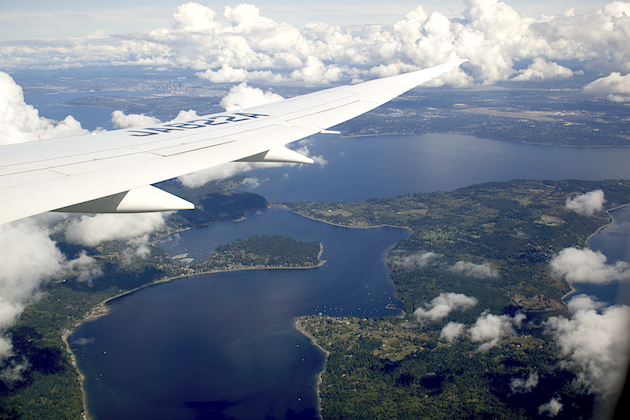
Consider shipping a box full of light items ahead of you to the hotel via FedEx 2nd day air. It’s worth the cost not to have to drag heavy items with you. Just be sure to check what items are prohibited by Customs in Japan before you ship. Prohibited items will be confiscated and destroyed by Customs. Surprisingly, Japan has very strict rules on importing meat products, and raw fruits and nuts. Most western packaged food is fine. Use common sense.
An even better way is to just buy clothes in Japan when you arrive. Tokyo is the fashion capital of the world and good cheap clothes are everywhere. Clothes are actually really heavy, and it may be worth it just to bring 2 changes of minimal light clothes with you, then buy everything else when you arrive. Most hotels in Japan have coin laundries for washing clothes.
Bringing knives, and medicines into Japan can also be problematic. And they’re real serious about it. Even western meds such as Benedryll and cough syrup are considered narcotics by the Japanese gov’t and can land you in a Japanese prison if you bring them into the country in your luggage. Firearms + ammunition of all kinds are absolutely banned. If you bring them into the country, you’ll be arrested + thrown in a Japanese prison immediately. Don’t even think about it.
Japan is also strict about quarantining sick people entering the country. In fact, as you pass through customs, your temperature will automatically be taken by remote control without your consent as you pass through. If you have even a cold, or fever, or worse, when you arrive, you might be placed in quarantine. Again, they’re real serious about it.
Also be aware that Japan is a country of climate extremes and can be extremely cold in winter, and extremely hot + humid in summer. Spring and fall tend to be shorter and more mild due to Japan’s northern latitude. Pack appropriately.
Navigating the major airports in Japan
Japan’s major airports are: Narita (east of Tokyo), Haneda (in the south end of Tokyo, near the bay), and Kansai International, in Osaka Bay. Their symbols are NRT, HND, and KIX, respectively. Narita is actually far outside Tokyo. You will need to take the Japan Railways Narita Express (NE’X), a slower train, or a bus into Tokyo from Narita International Airport. See this site for ticket info. Haneda has recently be modernized to add more flights, but it can still get congested at times. The big advantage to flying in to Haneda is the trip into the city is shorter.
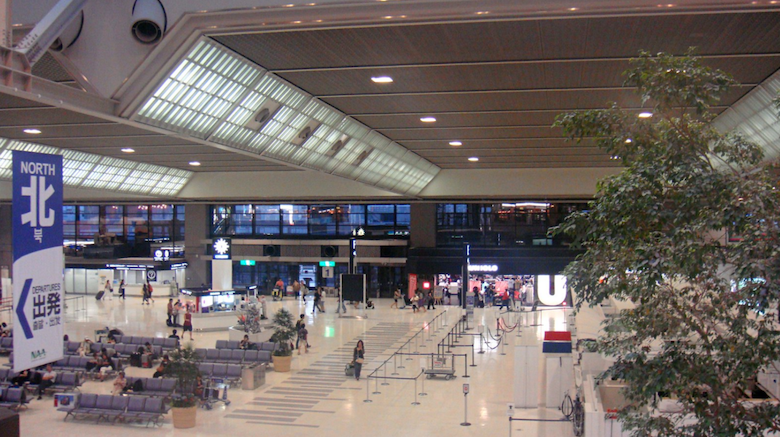
If you are flying into KIX, there is an excellent train at that airport called RAPIT (that’s the correct spelling), which shoots you directly into central downtown Osaka stations such as Namba, or the newly remodeled Osaka Station.
For Tokyo the pros and cons of each airport in a nutshell are:
Narita – farther from the city, takes 40 minutes to get into Tokyo, even using the NE’X, but it’s also bigger, and less congested.
Haneda – at the south end of the city. It’s more congested, and smaller but is much shorter to get into downtown Tokyo than from Narita.
Kansai International – Fly into KIX if you want to go to Osaka or Kyoto. You can catch local trains from downtown Osaka to Kyoto which take about 35 minutes and are cheap. If you want to go into downtown Osaka from KIX, just get on the RAPIT at KIX, then get off at Namba or Umeda stations, and you’re there. There’s also a great Osaka Station guide.
Once you arrive at Narita, you’ll need to collect your luggage, get through immigration, then Customs, then Quarantine. If you make it through all 3, you’re home free. Narita International can be really confusing. There aren’t a lot of signs, and it’s easy to get lost. So here’s the quick guide to navigating Narita:
When you land, exit the gate, turn left, unless you’re connecting to another international flight – in which case turn right. Follow the signs to “Domestic Arrivals”. You’ll go down several long corridors + people movers, then have to walk some more. Once you get to immigration, get in line. When you reach the front, an agent will direct you to fill out a simple immigration form with basic personal info. You then present this form + your passport or visa to another agent who will clear you. Once you get through that step, go down one level to collect your baggage if any. Watch the screens for the baggage carousel number for your flight. You might want to get a free baggage cart near the carousels if you have a lot of luggage.
Once through that, you’ll have to fill out another form for Customs. The forms are in tiny boxes at the end of the baggage carousels and they are not clearly marked. Usually you’ll just be asked if you’re bringing any prohibited or restricted items into Japan – or more than $10,000 USD in cash. Fill out the form, and hand it to a Customs agent. Once you’re cleared, proceeed directly ahead to the exit. It’s not clearly marked either, but it’s straight ahead. This brings you out into the main airport lobby. Turn right + walk down the concourse and you’ll find an Information Desk right next to a small coffee shop. You can ask agents there anything you like.
There are a few things you may want to do before proceeding to transportation: you probably will want to exchange some of your own currency into Japanese Yen (¥) at any one of the several currency exchanges there. Just be aware their rates are not the best and there are other places in Tokyo which have better rates, such as Sakura Exchange offices. We’ll talk more about currency exchange below.
You might also want to buy a phone SIM card to use in a GSM phone in Japan, if you have one. Western CDMA phones won’t work in Japan. Up until a few years ago, voice + data SIM cards for GSM phones were available, but due to crime by internationa, drug dealers in Japan, there is now only one Japan SIM card vendor which offers both voice and data to foreign travellers; a company called Mobal. See this article for a comparison of all foreign SIM card vendors in Japan. Another good article on SIM cards for foreigners in Japan is here. A US company called UltraMobile also offers an international SIM card for GSM phones at very low rates.
There are also luggage forwarding services in Narita International. For around $20 per item, you can have your luggage forwarded to your hotel. These are at the far right end of the concourse as you exit Customs. Luggage forwarding can save you a lot of struggle if you have multiple heavy items. Many hotels in Japan also offer luggage forwarding for an additional fee. There are also luggage storage places such as Yamato Transport and railway station coin lockers where you can temporarily store your luggage. More on that below.
You may want to take advantage of these services before you leave the airport.
All connections to trains out of Narita are down in the basement. The entry is near the Information Desk mentioned above. And this is clearly marked. Just take the escalator down. You may have to walk down several additional flights of stairs, so be prepared. If you have lots of heavy luggage, it will be a chore. We’ll cover trains in depth below.
If you want to take a taxi out of Narita, walk out any one of the front doors in the main concourse. But be warned a taxi ride from Narita into Tokyo will set you back $200 -$300.
There are also many good buses out of Narita to Tokyo. In fact, busses are the cheapest way to get to Tokyo – many of them are around or under $10. But it will take about 2 hours vs. 40 mins on NE’X. Search on Google for Narita bus companies.
Money in Japan – currency exchange, and money transfer options
There are a few tricks for currency exchange when going to Japan.
First off, the #1 thing you need to know is: airport currency exchanges are a total ripoff. Some American travellers report close to 30% fees at some major US airports. Don’t even think of paying more than 3%-5%.
You’ll need to change a little but of money into Yen (¥) before you go – just to be safe in case you need to take a taxi, buy food, get train passes, and other small incidentals.
But for the most part, you’ll want to exchange most of your currency in Japan. If you take more than $10,000 USD into Japan, you’ll also need to fill out a Customs form on the plane, or at immigration in Japan.
Japan is a cash society, and credit cards and debit cards are not accepted in many places. So, while in Japan you’ll need to carry lots of Yen. For currency exchange, here are your options, in order from least desirable to most desirable:
- Airport Exchange Counters – in both countries. In general these are too expensive so you’ll want to limit the amount you exchange at airports.
- Your bank at home before you leave – you can order foreign currency from your local bank before you leave, which may take a few days – so plan in advance. This is also not a good option since most US banks will charge you around 10%.
- ATMs – some Japanese ATMs accept foregin bank cards and debit cards. Visa is the most accepted in Japan. But not all Japanese ATMs will accept foreign cards. Check with your bank first to see if they work in Japan. In general business debit cards are your best bet for ATMs in Japan. Both Bank of America and Charles Schwab offer US ATM business cards which work at many ATMs in Japan. So consider opening a business bank acct. in the US and get an ATM or debit card attached to it well before you go. The easiest ATMs to use in Japan that work with US cards are 7-11 (called 7′ and i’) in Japan, SMBC banks, and Japan Post post offices. You can actually walk into most Japan Post offices, slide your card in, and withdraw cash. Many hotels and hospitals in Japan also offer ATMs in their lobbies. Different ATMs and banks will change different fees for withdrawls. As of this writing Bank of America charges 3% per amount withdrawn. 7-11 ATMs in Japan also charge 3%. By far the best deal is Charles Schwab, which charges no fees whatsoever for overseas withdraws. You can read more about 7-11 ATMs in Japan here.
- Online currency exchange – online services for currency exchange have popped up, but by far, the best one is Transferwise. PayPal also offers instant money exchange, but to remove your money as cash in Japan, you must first have a Japanese bank account in that country. There are other exchanges such as OFX, which are also very good. If you are sending cash to someone else in Japan, there is also always Western Union. The big advantage of WU is the recipient can pick up the money at at WU counter in Japan with just an ID.
- Local currency exchanges – there are several small hole-in-the wall offices in Japan which specialize in exchanging currencies. For direct exchange, these are by far the best value. Some of them, such as Sakura Exchange do direct conversion with no fees. You won’t get exactly the market rate, but you’ll get close – and you won’t pay 3% either. In many of these exchanges, you’ll pay as little as 1% for exchange. Most of the exchanges in Tokyo have English-speaking Japanese staff, but we have also heard reports that sometimes the exchanges are staffed by foreign workers who have reportedly tried to rip customers off on occasion. So be careful. You will need to do the math yourself when you do the exchange. The offices can be a bit hard to find. Sakura Exchange has several offices in Tokyo near train stations, so you’ll need to map them on Google Earth to find the one you want. The easiest one by far is just 2 blocks north of Shibuya Station in Shibuya.
So what do we recommend? By far the best deal is a zero fee debit or ATM card from Charles Schwab. Just keep in mind withdraws from overseas ATMs will likely be limited to $1000 per withdraw. The second best deal are the local currency exchanges in Tokyo. We recommend Sakura Exchange. The other huge advantage to using a local exchange is there generally is no limit on the amount you can exchange at a time – walk in, drop a big stack of cash, and they will exchange it on the spot – you walk out with a big pile of local currency. Just remember to exchange a few hundred dollars for incidentals at home or at the airport before you leave so you have a little bit of Yen when you arrive in Japan.
For B of A customers, see this page.
Booking info + websites
We’ll come right out and say that most of the US booking sites are lousy: hard to use, confusing, poorly designed, and limited on payment options. Everyone goes to sites such as Expedia.com or Booking.com, but hands down, the very best booking site online is agoda.com. Agoda has a simple, easy interface, lets you set all options for booking such a smoking/non-smoking, free breakfast, cancellation, and other options right on each property’s page. It even lets you book a reservation for someone else using your credit card. It also offers options for pay now, pay later, or even pay at the property on arrival. Since Japan is a cash society, this is an awesome choice. It also shows you which reservations can be cancelled, and the date up to which you can cancel. Using agoda.com will make setting your trip up a thousand times easier. Just a few clicks, set your options, reserve. All your booking info is also stored in the site, so you can log in from anywhere later + view your entire itinerary. It’s awesome.
Transportation – how to get around in Japan as easily + cheaply as possible
In Japan there are 4 basic modes of transportation:
- Walking
- Bicycles
- Autos
- Trains
By far trains are the most commonly used – trains are usually packed, especially in urban centers. Try to avoid rush hour if you use the trains.
However, a lot of people cycle in Japan too – including ypoung housewives with small children and very old people. It’s not uncommon to see people over 70 or 80 riding bikes here. People cycle everywhere. The 1 big downside to cycling in Japan is the parking (see below).
People also walk everywhere – which is perhaps one reason the Japanese are so healthy and have long life expectancies. If you plan to come to Japan, you’d better be prepared to walk – a lot. Like 5-10 miles a day a lot. And up and down train station stairs – a lot. Walking here daily will get you in shape fast.
For trains you have several options:
- Buy paper tickets at stations.
- Buy + reload IC cards such as Suica or Passmo and use them at station turnstiles.
- Buy a regional or nationwide Japan Rail Pass.
Here’s a short tutorial on dealing with the rail systems. Once you get used to it, it’s easy.
- There are several different systems: JR (Japan Rail), Tokyo Metro (Subway), Toei Subway, and Keisei Railways. There are a few other minor ones as well. For the most part you’ll use JR and Metro.
- If you order one of the rail paases online, you will be mailed a voucher, which you pick up at your hotel or at one of the JR service centers in Japan – such as the main one in Shinjuku or Ikebukuro. You can also exchange your voucher for the rail pass at the airport when you arrive.
- Despite what people may tell you it is possible to buy a rail pass once you are in Japan – at the JR Ikebukuro service center, for instance. But you must buy it in person, show your foreign passport, and not be a Japanese citizen in order to make the purchase.
- If you plan to use the trains a lot, a rail pass may be the way to go as it allows yout to save ¥ by breezing through ticket turnstyles at stations.
- If you plan to use the trains only a litle, then a Suica or Passmo card may be better. Suica and Passmo are electronic (IC) cards. You buy one at most JR stations, add money to it, then pass it over a sensor on turnstiles in stations as you enter and exit. Your fare is automatically deducted for each trip. When your card runs out of $, you can add more by using a Fare Adjustment Machine at most JR stations. If you go to exit a turnstile, and your card doesn’t have enough ¥ left on it, don’t panic, just turn around and go to the nearest Fare Adjustment Machine, insert your IC card, press the English on-screen button, then the button for adding fare, then press the Confirm onscreen button – your IC card will be ejected from the machine with more ¥ added to it. You can then go through the turnstile again by passing your card over the IC reader.
- You can also use Suica and Passmo cards at many stores and post offices to pay for things. IC cards make the train system much easier to use.
- When using trains at rush hour or at crowded stations, be ready for a lot of people, and be ready to be packed into a train with lots of other people. When lining up for a train at a packed stations, there’s only one way to deal with the rush: make sure you are first in line or near first in line for the next train. The worst thing you want is to be in the middle of a long line as you’kll usually end up in the center of a car with people packed around you on all sides. Making sure you are near the front of the line when the doors open means you will enter the train first, and get your choice of where to stand (or sit if seats are available).
- In rare cases, be ready for emergency brakes to be used which could send you flying. With millions of people riding Japan’s trains daily, Human Damage Incidents (suicides, jumpers, peopple being pushed on tracks, people falling onto tracks) are not uncommon and you’ll likely encounter one before long.
- As of this post, Japan is busy renovating many of its train stations in preparations for the Tokyo Olympics in 2020. This means new facilities, but it also means if you’re there during renovation, you may be inconvenienced by construction.
- Most of the new stations will have full handicapped access, escalators, and elevators, IC card terminals, and kiosks. Even many of the more remote new stations will have more restaurants and shops right in the stations themselves, to make things more convenient.
- There are big express trains that run from the airports – especially NE’X and Keisei Skyliner from Narita International. In Osaka/Kobe the RAPIT train runs to and from Kansai International Airport (KIX) which sits out on a man-made island in Osaka Bay. (There is also a great luggage forwarding service at the Keisei Skyliner Ueno station which will forward your bags in either direction for $9/bag).
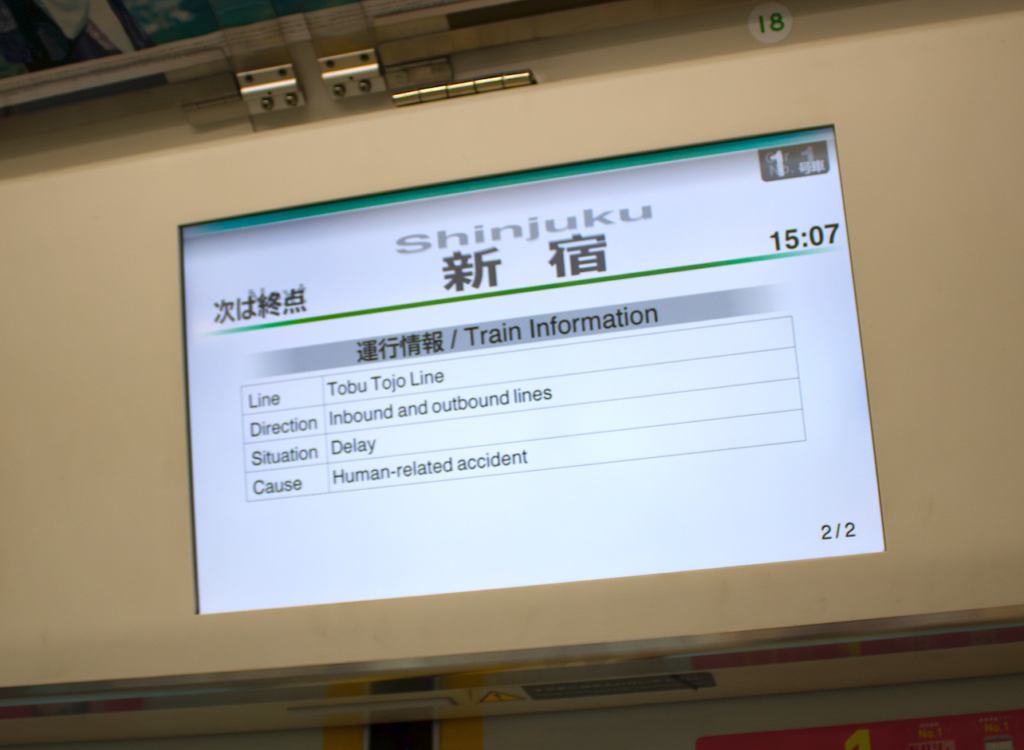
An unfortunate human-related accident has caused a delay on the Tobu Tojo Line.
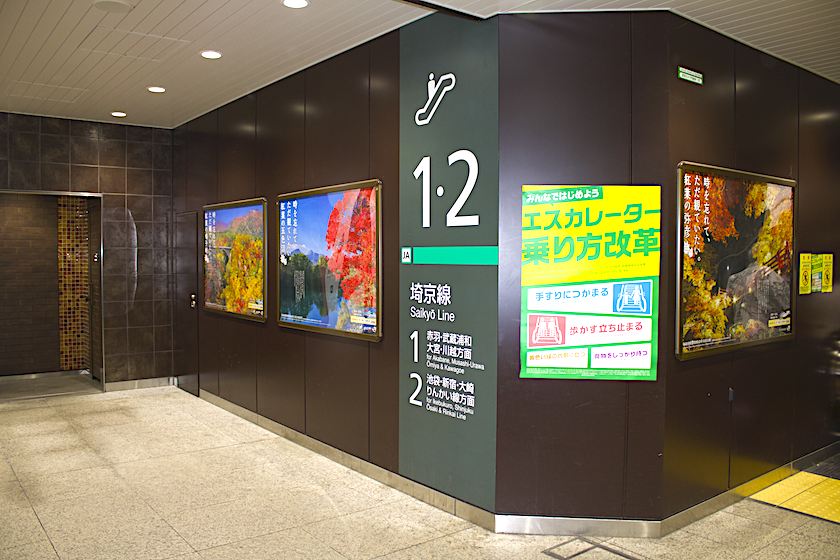
Itabashi‘s beautiful brand new renovated JR station.
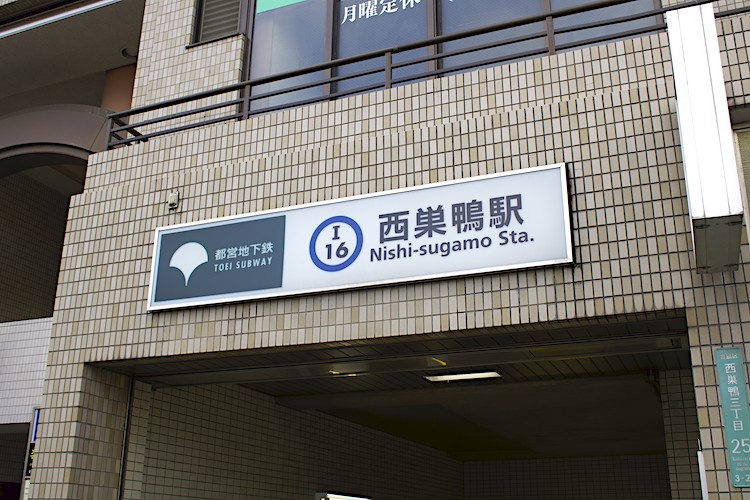
A Toei Subway station in Sugamo.
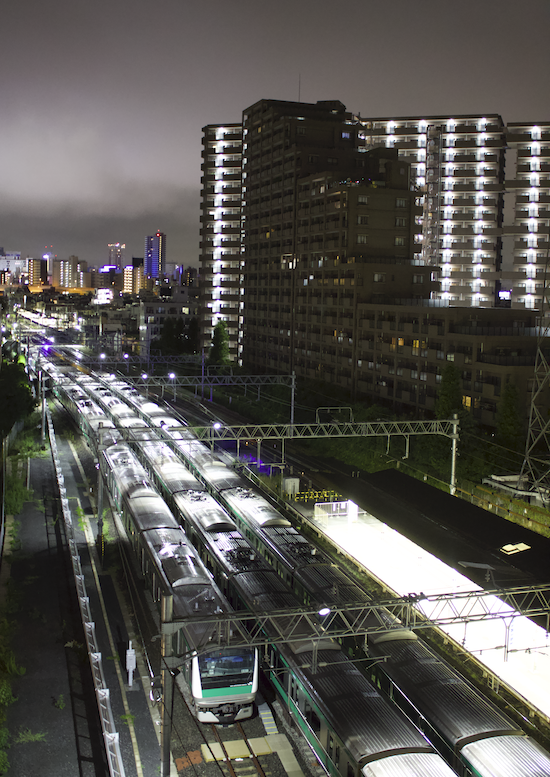
JR Itabashi Station at night.
See the huge links section at the end for complete rail info.
Cycling
Cycling in Japan has not yet caught up with the rest of the world, but is still popular. New bike lanes are being built, but there are still far too few of them given the huge size of Japanese cities. Many people ride bikes on sidewalks, or simply brave traffic on city streets. Be careful on backstreets as many Japanese will fly thorough intersections on their bikes at full speed without stopping. If you’re not careful at intersections, you could collide with another cyclist.
Most bikes in Japan require a small registration sticker on them so that if they are stolen, they can be tracked. If you buy a bike in Japan, you’ll need to work out registration with the bike shop and the local police.
The one crazy thing in Japan about bikes is that in most cases it’s illegal to just park them anywhere. Instead you have to park them in designated paid bike parking lots. In most cases you’ll have to feed a bike parking machine twice a day ranging anywhere from $1 to $6. Most are around $2/day. If you don’t park your bike in a designated lot, and just lock it up anywhere, it may be impounded by the police. Not a good idea.
The bike parking lots are a bit crazy – the machines are usually in Japanese only, and at first don’t appear to work consistently. Usually you roll your bike up on a rack at a lot, you’ll hear a click. In most cases you pay when you come back to get your bike out. To pay, in most cases, you enter your slot number on the machine, then press a button, then enter the amount shown on the display. There’s also a button for a receipt if you wish. The weird thing is some lots allow free parking for the first few hours, so even if you try to put ¥ in initally, the machine will tell you you’ve already paid – but in Japanese on the display. In these cases it’s only later (like 6 hours later) that you’re required to pay again. This can confuse the hell out of you. If you’re not sure after locking your bike in the rack, and you don’t read Japanese, try to ask a local what the machine is telling you. In most cases it’s telling you you’ve already paid (i.e. that it’s free for the first X number of hours). You’ll need to come back in 6 hours to see if you need to pay again. It may take some time to get used to the machines.
Other types of bike parking racks have a box + slot for coins on each rack itself – along with a long thick wire cable used to secure the bike. These machines you feed coins into directly and are harder to use.
Food + dining in Japan
Myths abound about how expensive it is to eat in Japan. This is not entirely true.
Yes, top good restaurants might cost a pretty penny – a good meal at a good upscale restaurant might cost $60-$100 USD.
But that doesn’t mean you can’t eat well for less in Japan.
There are some surprisingly good supermarkets in Japan with fresh food cheap. In general, the quality of supermarket food in Japan seems to be higher than in the west. Many supermarkets hold midnight sales to clear out excess inventory at dirt-cheap prices. If you take advantage of these sales, you can eat cheap.
There are also conbini (convenience stores) which have good prices. In Japan, most conbini food is fresher and of higher quality than in the US. You can get fresh great conbini sandwhiches for $1.50, drinks for $1-$3, and even cheap snacks. Some conbini have cheap pre-cooked meals in small plastic containers which only need to be microwaved. These typically are a full entire meal and only cost $4-$6.

Some conbini are built into train stations, such as this Kinokuniya mixed-use store @ Shinjuku Station.
There are also discount chains such as Don Quiojte, Can Do, and others which often have sales on good food cheap.
Tokyo and other major Japanese cities also have many good less expensive restaurants – great burger places abound, and there are all kinds of restaurants all over big cities in Japan with an endless variety of good stuff to eat. A really great burger in Japan will cost you $10-$14 but are well worth it, on occasion.
There are even some vending machines which sell hot + cold soups and sandwhiches right out of the machines.
So, sit back and enjoy the list of inexpensive foods in Japan.
We review a few foods with photos below.
Snacks
There is a huge variety of snacks in Japan. You can buy them at conbini, and supermarkets, but the best place is at discount stores such as Don Quijote, Can Do, SEIYU, and others. Discount places have snacks as low as $1.50 each. Some are good, some are not so good.
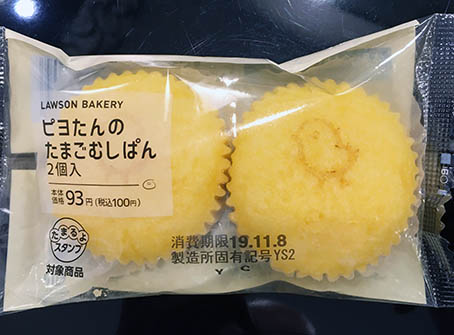
Conbini snacks such as these for around $1 abound in Japan. Not the healthiest, but cheap and quick nontheless.
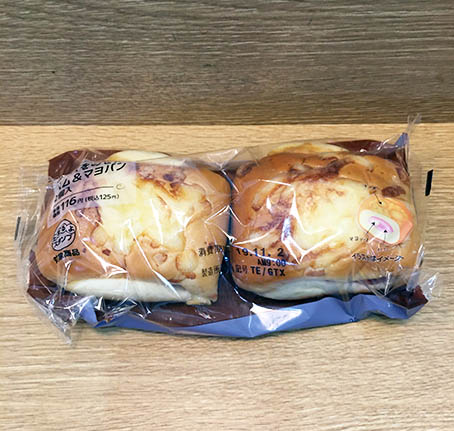
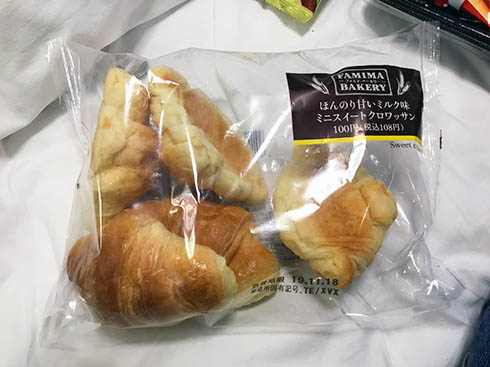
There are some crazy (and good) snacks in Japan. From Don Quijote to supermarkets, to conbini, you can find some strange, wacky, and tasty snacks in Japan, such as:
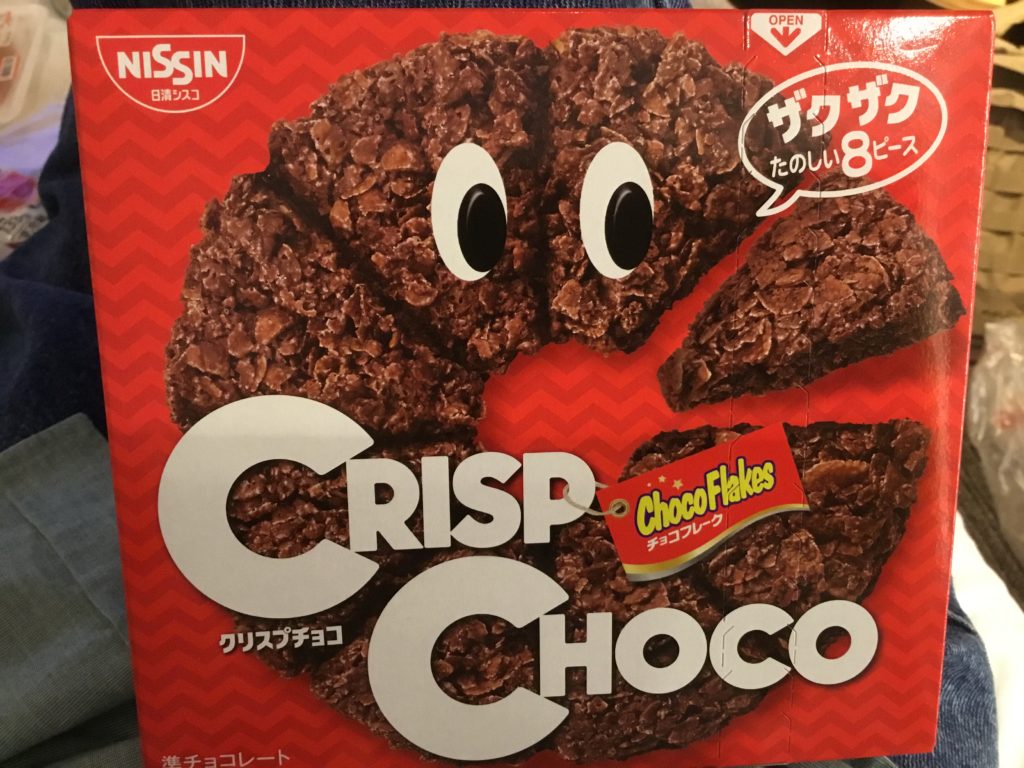

Lots of cheap snacks @ Don Qijote such as:
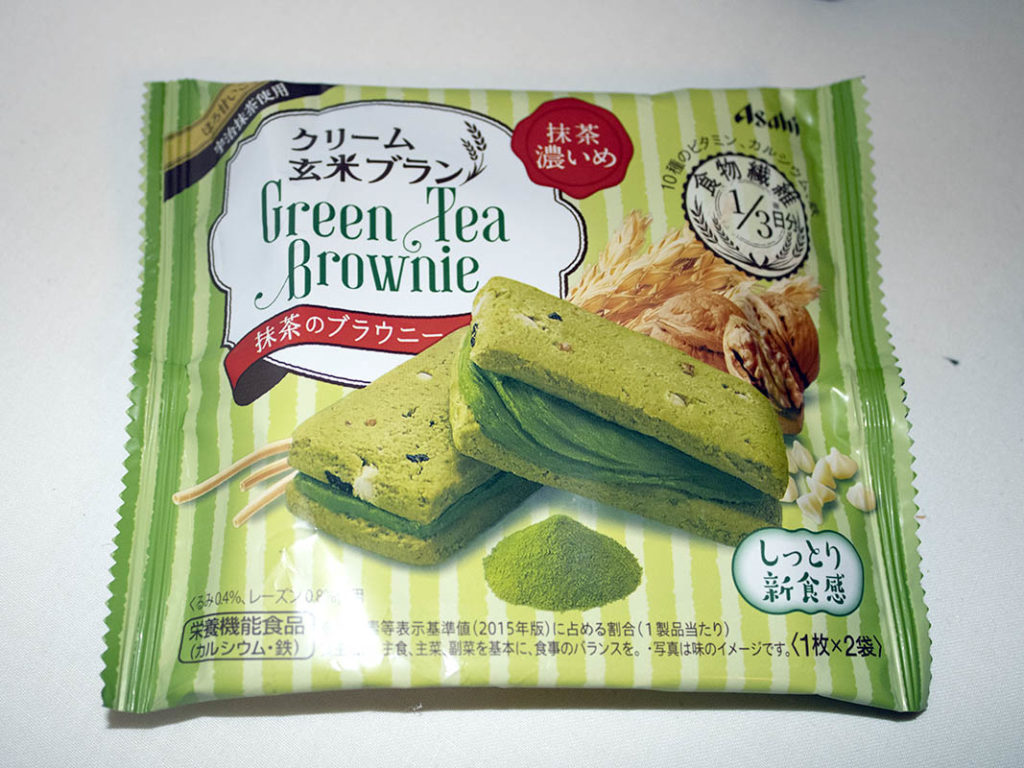



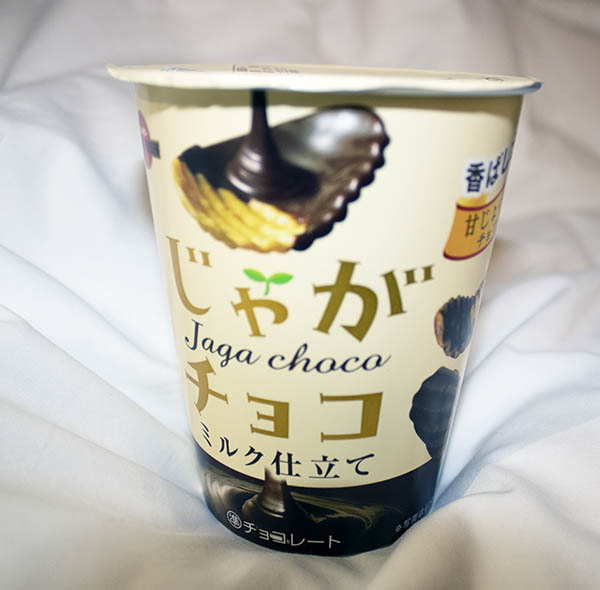
Even chocolate covered potato chips.
Conbini
Conbini (convenience stores) have a wide variety of good cheap food. In general conbini sandwiches are fresher and more natural than those in the west. You can get good salad/egg/cheese/ham conbini sandwiches for under $2.00 in most conbini in Japan.
You can also get a wide variety of drinks + bottled coffee in conbini too.
The cheapest possible breakfast in Japan is a $1.00 bottle of coffee + a $1.28 Tamagoyaki (fried egg) pack from Lawson. $2.28 for breakfast is hard to beat.
Consider the breakfast shown below: $1.00 for coffee, $1.28 for milk, $1.75 for 3 slices of ham, and $2.00 for a 4-pack of croissants from Aeon supermarket. Total: $6. If you cut the croissants out, $4. A very cheap meal. For desert we threw in a $1.25 chocolate donut as well.
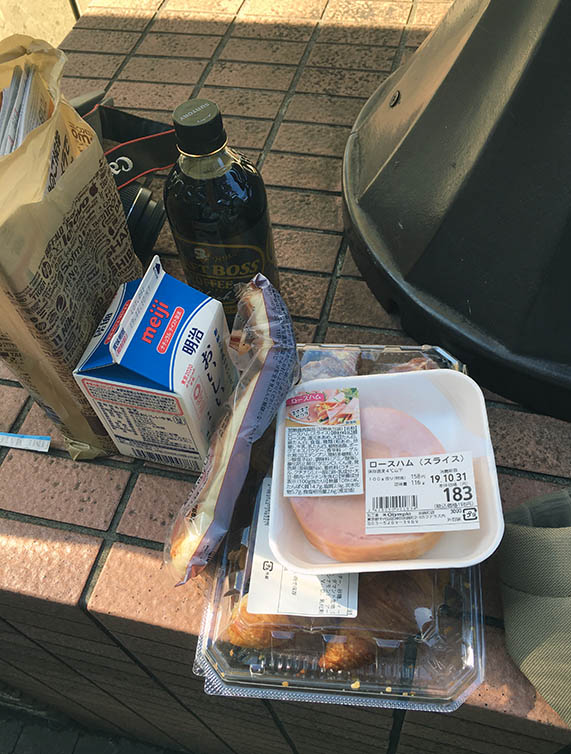
Salads + meals

Complete conbini meal – salad, drink, water, milk, green smoothie – $6 total.
Sandwhiches
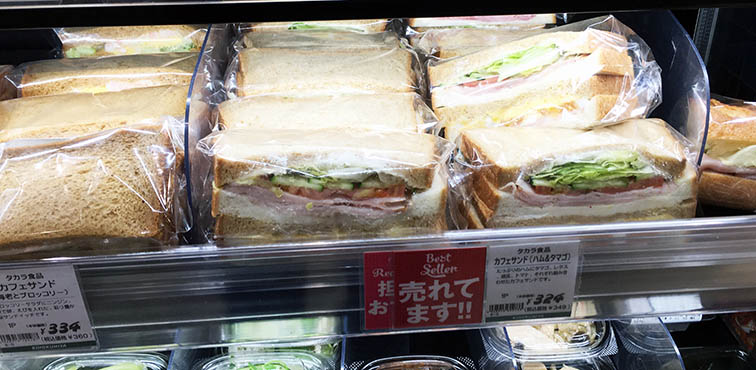
Good sandwhiches abound – many for under $3.50 USD.
Meats

3-pack of sliced ham – $1.50
Yogurt
You can get large yogurt containers for $1.50-$1.78 at most convenience stores and discount stores. Meiji seems to be the best brand, but there are others, Meiji brand is shown here:
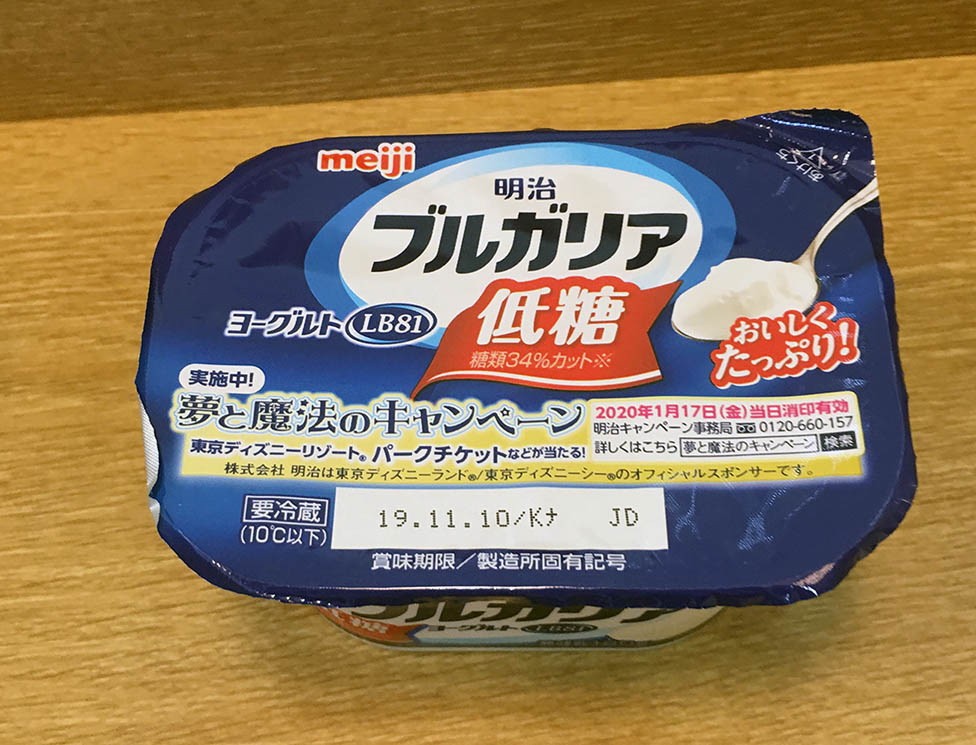
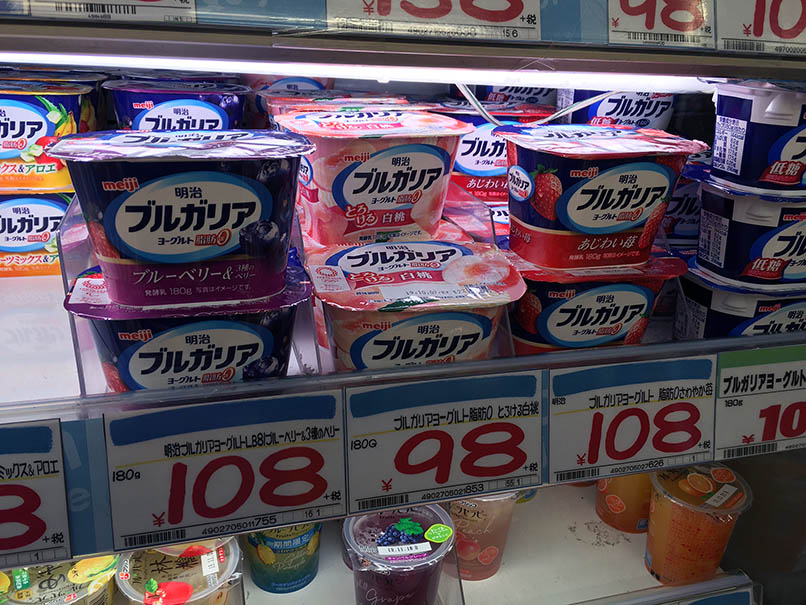
Drinks
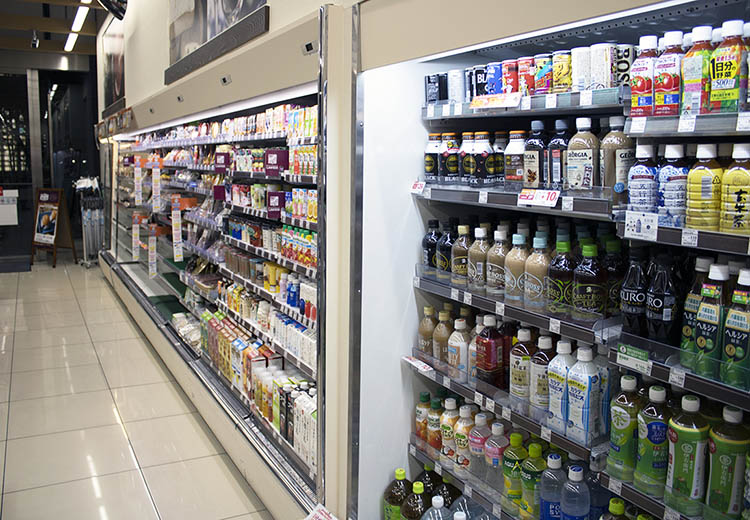
Both conbini and grocery stores in Japan have a wide variety of good drinks. In general soft drinks and sodas are better than in the west – containing less sugar and more natural juices. Water and milk are also around $1.00-$1.25 each. There are endless varietes of coffee, shown on the center right, here.

Vegetable Drinks
Incredibly, you can get 1 liter, 26-vegetable drinks for $1.78 @ Don Quijote, SEIYU, and other discount stores. Aeon supermarkets also sell them. They contain a blended mixture of 26 different vegetables – nothing else. They’re an incredibly quick, cheap, healthy way to eat. Just buy 2 + chug them down. $3.25 USD for an entire meal. They’re incredibly healthy + good for you. If you do this once a day, for dinner or lunch you can save up to $7-$10 a day/per meal. That’s $300/month. If you stay in Japan a few months on vacation, you can save $600 this way – just on this one thing alone. Well worth it.
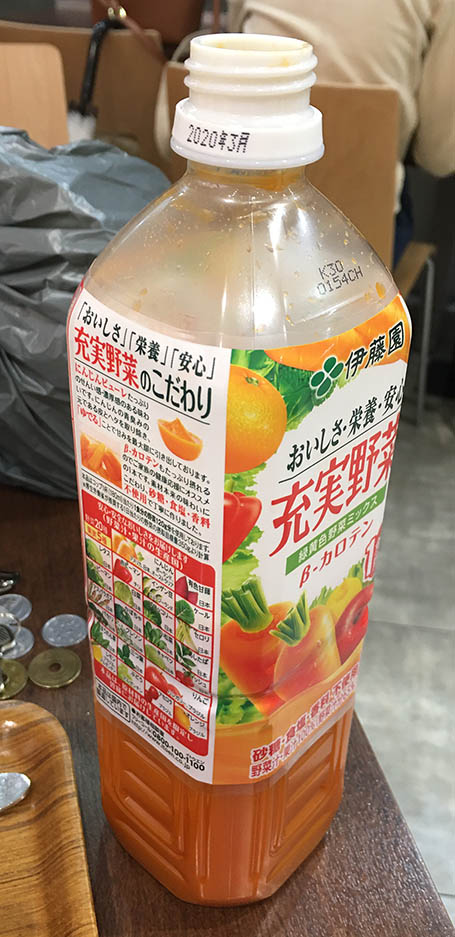
Mixed 26-veg. drink from Aeon – $1.78 US
Grocery Stores
There are a wide variety of great grocery stores in Japan – YorkMart, Life, SEIYU, Japan Meat, and others. All are excellent with very fresh food. Many are not that expensive. SEIYU seems to be the best discount store. SEIYU and Japan Meat can often be found in the basements of department stores right near train stations. We like the ones just outside Kinshicho Station – in PARCO‘s and OIOI‘s (pronounced “Marui”) basements.
Don Quijote also has small packages of folded paper towels for $1 – perfect for your backpack or bag.

Kinshicho Station, left. PARCO department store, right.


Entrance to SEIYU, in the basement of the PARCO Kinshicho dept. store. There is also an entrance to the Kinshicho Metro Subway station in the basement. To get here, exit Kinshicho south or west exit, head south to the PARCO, take the escalator down.
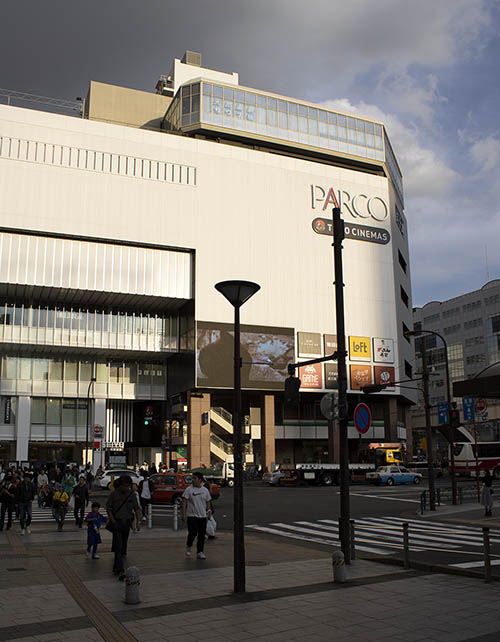
PARCO – just to the south of Kinshicho Station.

Large healthy salads abound for around $2. A healthy and cheap way to eat.

Cheap, good, pre-cooked meals also abound in Japan’s grocery stores. This midnight sale had some for under $2.50

$.25 bags of bean sprouts make a great cheap filler addition to any meal and are a good way to save $.

If you catch a midnight sale @ a grocery store in Japan, you can find great deals – such as an entire tin of butter cookies for around $1.00 – in this case at SEIYU. Good stuff.

Slip out Kinshicho Station‘s central (west) exit, cross the street to Marui dept. store shown here, and head down to Japan Meat in the basement.
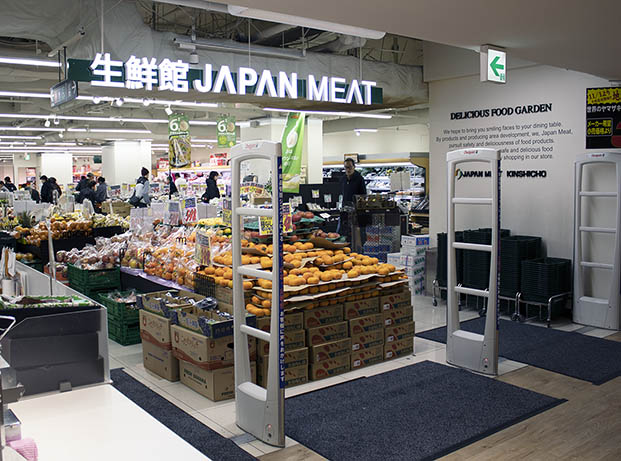
Japan Meat entrance in Marui‘s basement.

Checkout in Japan Meat.

Great meat deals @ Japan Meat. $1.00-$3.50 for chicken and pork.


If you feel adventurous, and can find a spot to cook, you can even use a small camp stove to cook meat. The best place to buy camp stoves + fuel in Japan is at Xebio SuperSports.

YorkMart grocery.
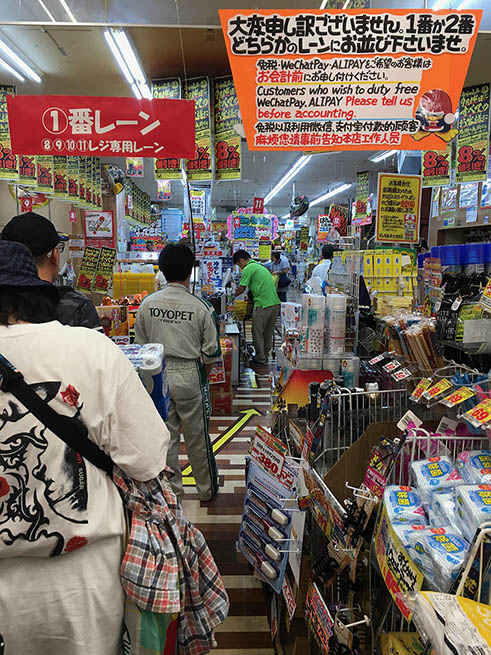
Inside the craziness that is Don Quijote.

More cheap, good yogurt – $1.25 for one pint @ SEIYU.

Another midnight sale. Not the healthiest – but cheap – around $1.50 for 3 corn dogs. Purchased @ YorkMart.
Burgers
Japan, and Tokyo in particular, have lots of great burger places. Brozer’s on the top floor of the Takashimaya Annex Bldg. 2 blocks east of Tokyo Station has great burgers and other sandwiches for around $10. Definitely worth a trip.

Brozer’s in Takashimaya Annex, Nihombashi, Tokyo
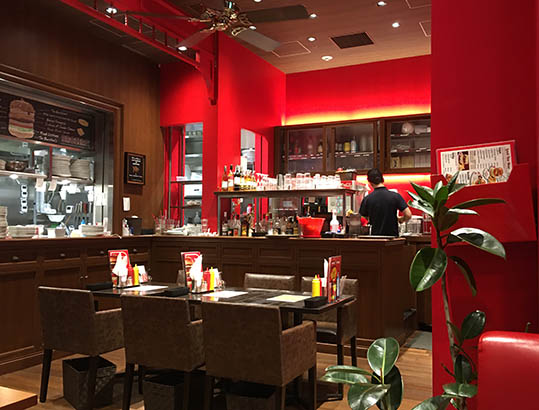


Numerous good smaller burger places abound – such as Darcy’s hidden in the backstereets of Ikebukuro.
Coffee
Don Quijote has both bottled, carton-ed, and ground coffee for very good prices. A 1 liter carton of black coffee will set you back a mere $.75 USD – an incredible deal. If your hotel or hostel has a fridge in it, you can make one of these stretch 2 days – $.37/day for coffee, not $7 for one cup at a café.

You can get a small jar of honey to use in coffee as a sugar substitute for under $2:
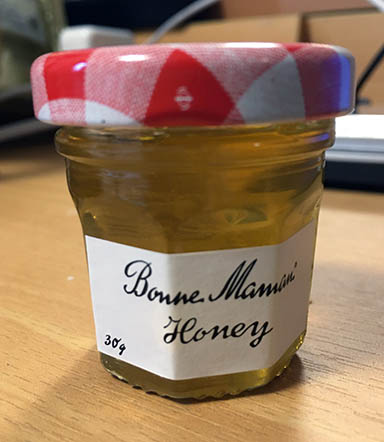
Canned food
Both groceries + discount stores have some good canned food cheap – fish, ham, chicken. $1.50-$4.00 depending on brand and quality.
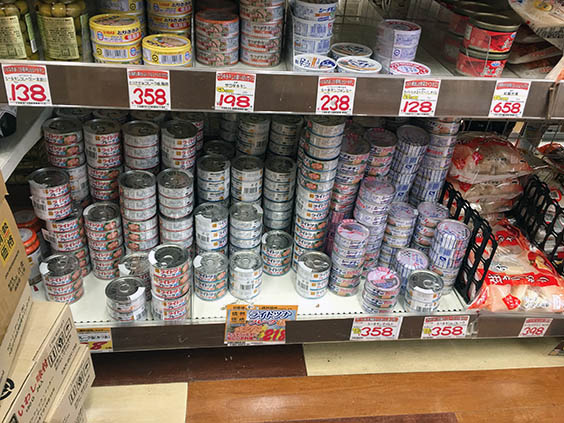
Fish
Amazingly, 7-11 sells very high quality packaged fish in most supermarkets in Japan. $2.75 gets you a nice fresh package of salmon. A great way to save $.
Since Japan is a seafood nation, most groceries have vast amounts of freshly-caught fish for very low prices. Look around most stores to find good deals on fresh fish.

Food Parlors
Most 1st-time visitors to Japan are shocked to discover that the Japanese, despite their good health, and diminutive size are voracious eaters. This is because Japan is a pedestrian society. The average Japanese walks 5-10 miles daily. Up the station stairs, down the station stairs, through train station tunnels miles long, walking everywhere. As a tourist, you will quickly realize after walking all day you want to eat everything in sight.
As a reward, they eat, and eat well. Food is everywhere in big cities in Japan, in vast quantities. Japan has “food parlors” – a throwback to 1950’s-style fine dining. There are restaurants for just about everything. Most dept. stores have food palaces in their basements or on their top floors. All are generally pretty good. There are even entire buildings of 12 floors or more dedicated to food and restaurants – the DAIMARU food palace at Tokyo Station and others. Forget Paris or Italy – you want to eat – Japan is the place to be.

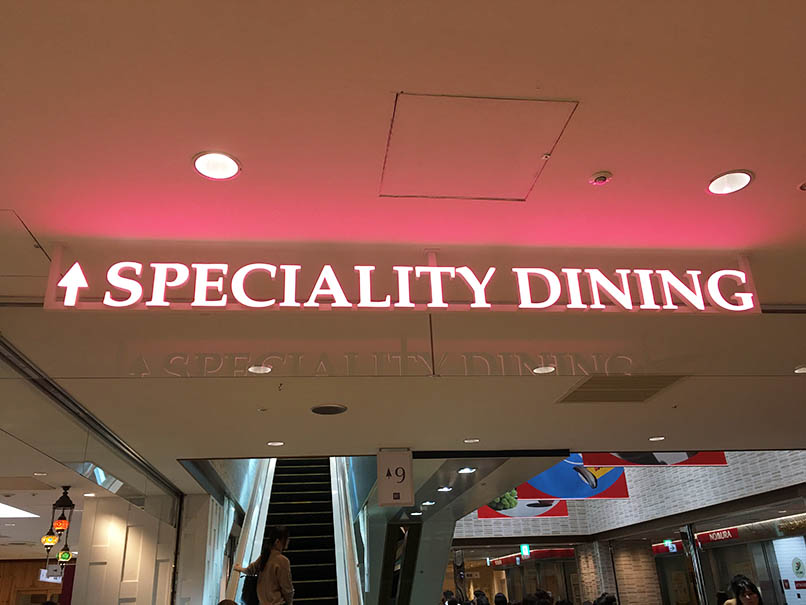
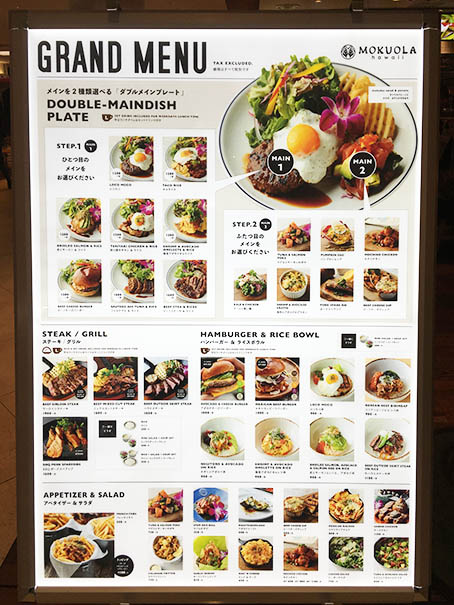
When it comes to food, in Japan, they don’t mess around.
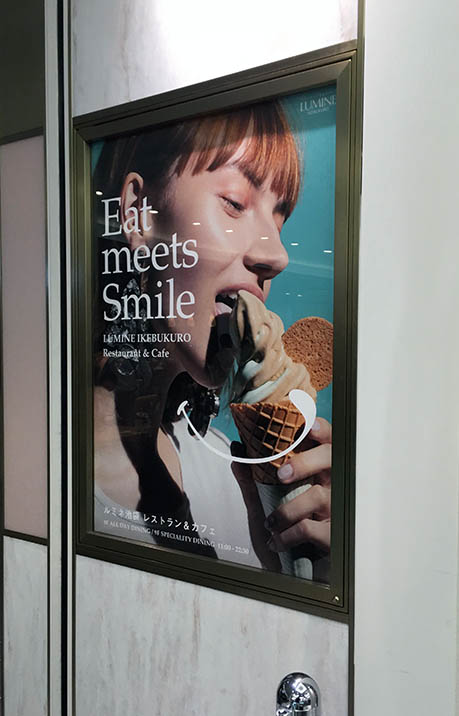
In Japan you can pig out like a native and never gain weight.

The incredible 10-story DAIMARU food palace @ Tokyo Station.

Desserts
Surprisingly, Japan loves deserts + sweets. They can do this without getting fat because they walk 10-15 miles on average per day. Japan is full of an abundance of deserts everywhere you turn. From cheap sweets like the Hokkaido Cream Roll shown below to higher end cakes + cookies in packages, to all kinds of deluxe food parlors, pancake shops, and dessert palaces, which we will discuss next.
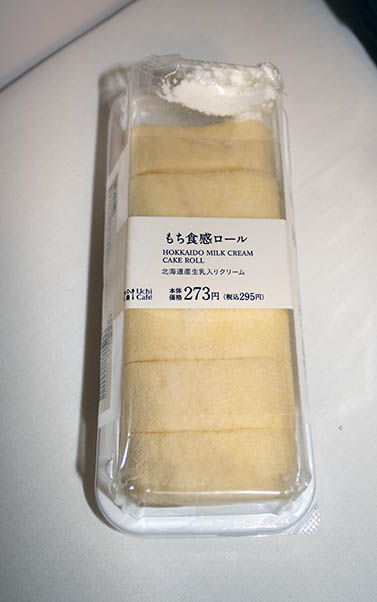
Dessert + Fruit Parlors
There are even fruit and desert-only parlors in Japan, such as Takano Fruit Parlour in Shinjuku shown below.
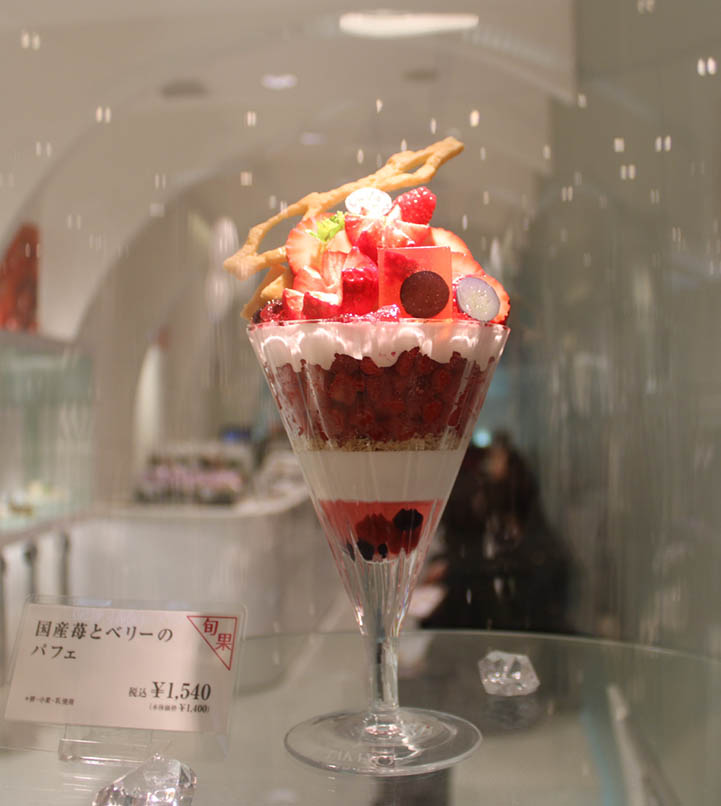
Takano Fruit Parlor, Shinjuku
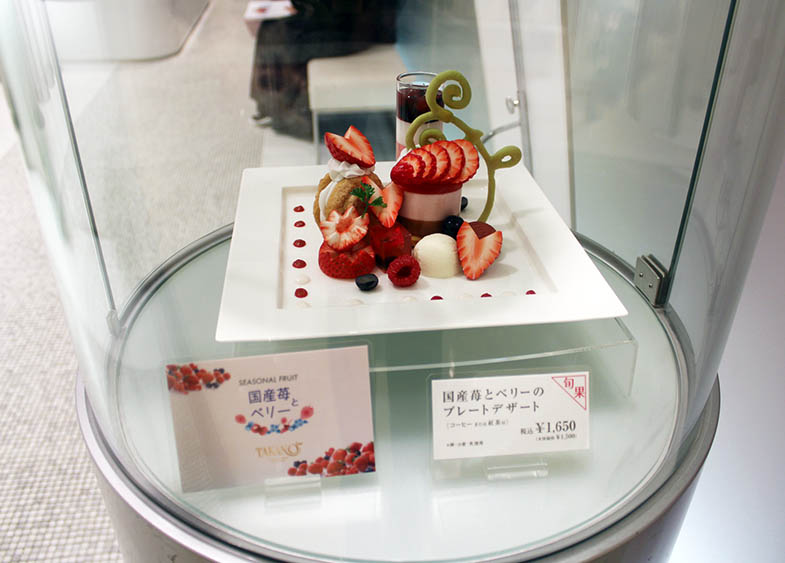

More desserts
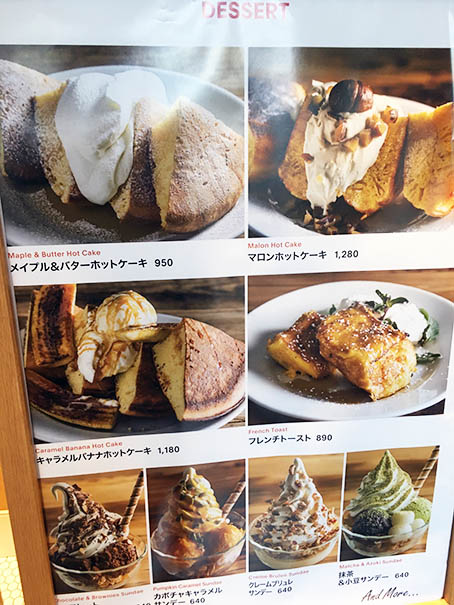
Heaping plates of all kinds of deserts.
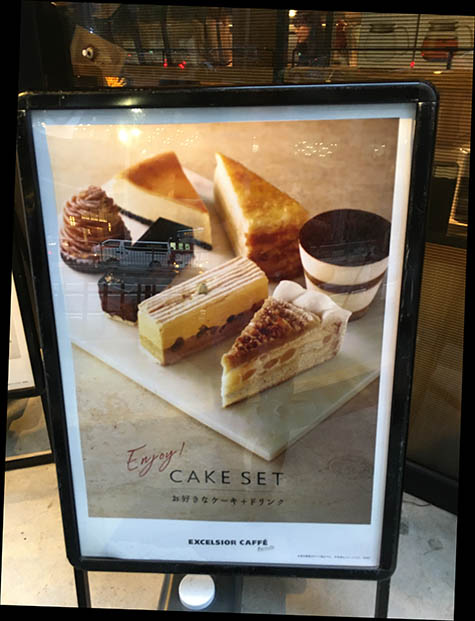
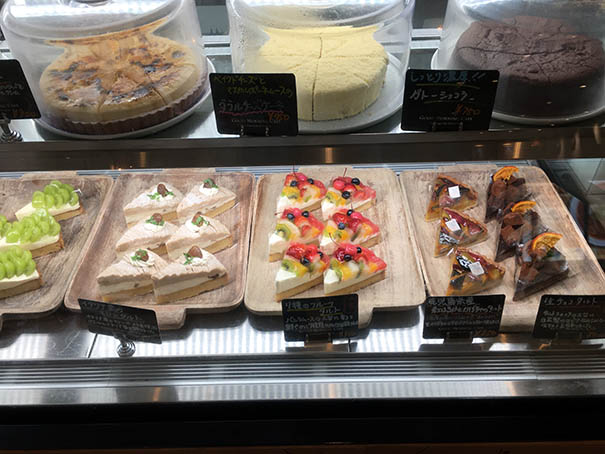
Pancake Palaces
A pancake craze has hit Japan big time. There are big pancake restaurants everywhere and their number keeps growing. The most famous of these is Happy Pancake – one in Ikebukuro, Omotesando, and Ginza. A new one has recently opened in Hong Kong as well. Well worth a trip. Around $10-$15 for just about every variety of pancake you can imagine. There are plenty of other smaller ones as well, such as Flippers, shown below. Happy Pancake Ikebukuro is just a few blocks east of the east exit @ JR Ikebukuro Station.

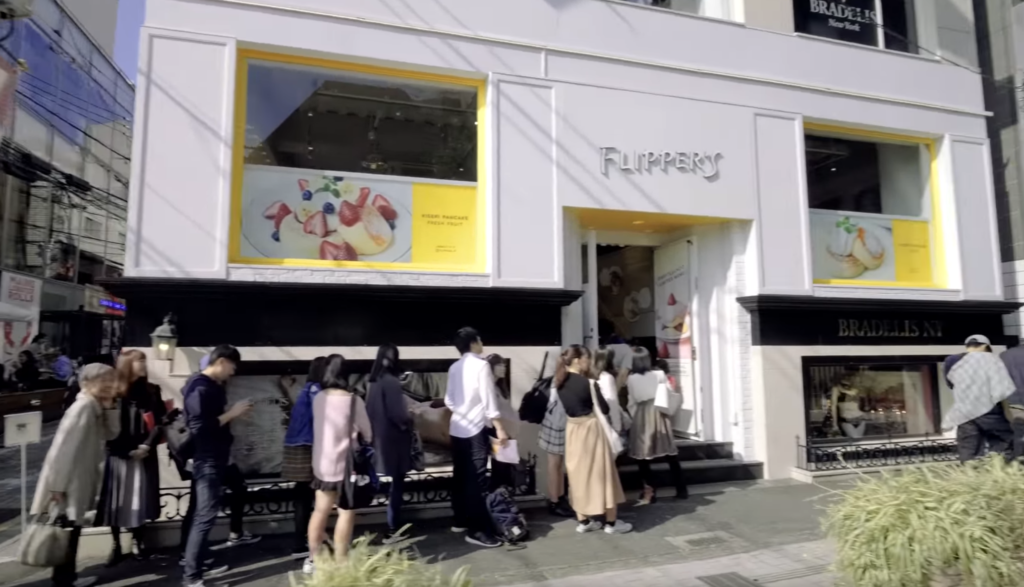
Flippers – a very popular pancake palace in Omotesando, Tokyo. The Japanese love their pancakes. So much so they will wait in line for them.

Rainbow Pancake in the food court @ ODAKYU dept. store in Shinjuku.
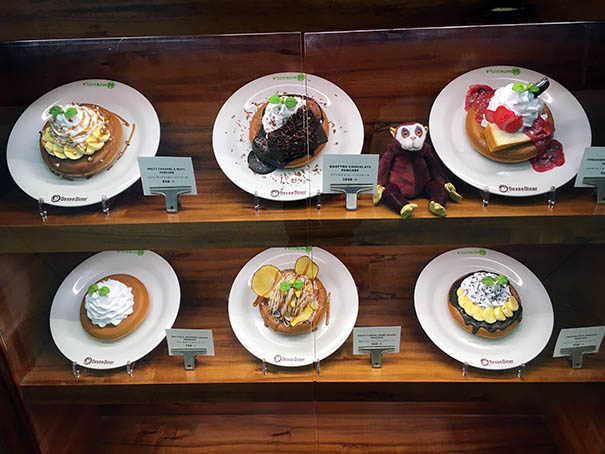
Window of a pancake palace in TOBU dept. store, Ikebukuro. If you want pancakes, Tokyo is the place.
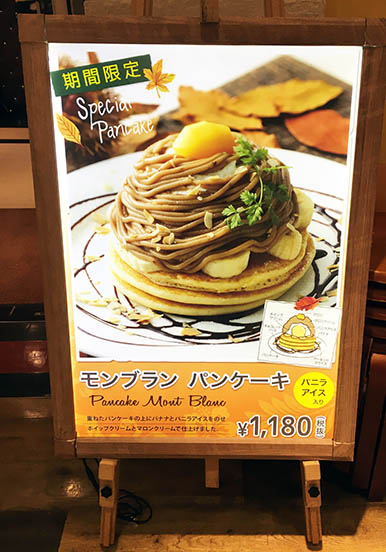
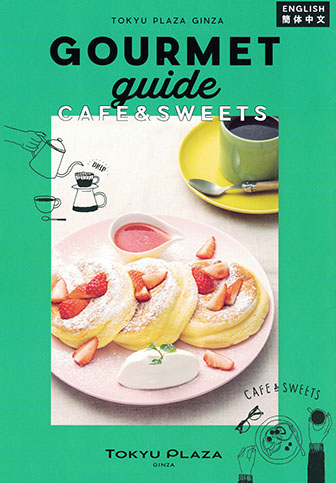
Pancake mania @ Tokyu Plaza Ginza

Milky Way pancake + ice cream parlor, Ikebukuro
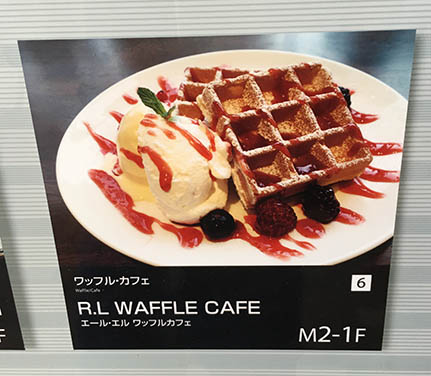
R.L. Waffle Cafe @ Tokyo Station which is very good.
Food basement shops
Many dept. stores in Japan have food basements – huge floors where vendors sell both meals and desserts. Many of these Deepichika also have gift vendors which sell packaged gifts. TOBU, Isetan, PARCO, OIOI (Marui), Matsuyakaza, and SEIBU are just a few. There is also a huge Keio dept. store + food basement just outside the west side of Shinjuku Station, which is very good.

Food basement, Mitsukoshi @ Nihonbashi

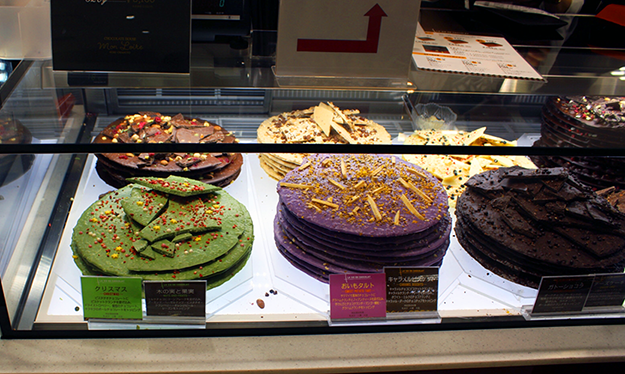
Giant cookies the size of pies in the food basement of Keio Shinjuku.
Dessert Buffets
Many hotels in Tokyo also run elaborate seasonal-themed dessert buffets on their restaurant floors, such as this one:

Dessert buffet @ Sunshine City Prince Hotel
Cafes
Cafes abound in Japan. You might say they are even more popular than in the US. Much more. There are small independent cafes and larger chains. The larger chains are:
Cafe Veloce
Doutour
Excelsior Cafe
Tully’s Coffee
Mister Donut
Cafe Crie
Starbucks
We won’t go into rankings, but let’s just say in our opinion we like Doutor and Excelsior Cafe best with Tully’s a close 3rd. Cafe Crie is IOHO not that great – the food tends to be of lesser quality. Tully’s has charge ports and AC outlets in almost every store. Cafe Veloce is sort of a throwback to the 1950’s style diner. Its only drawback is it tends to have more smokers. Doutor is hands down the best for food value/price. You can get great hot dogs and small sandwiches for under $3 along with coffee for around $2.50 – half what the big chains cost. Definitely worth a look. There are all kinds of great cafes around Tokyo Station, Shinjuku, Shibuya, and other city areas. Here are a few photos of some of the cafes:

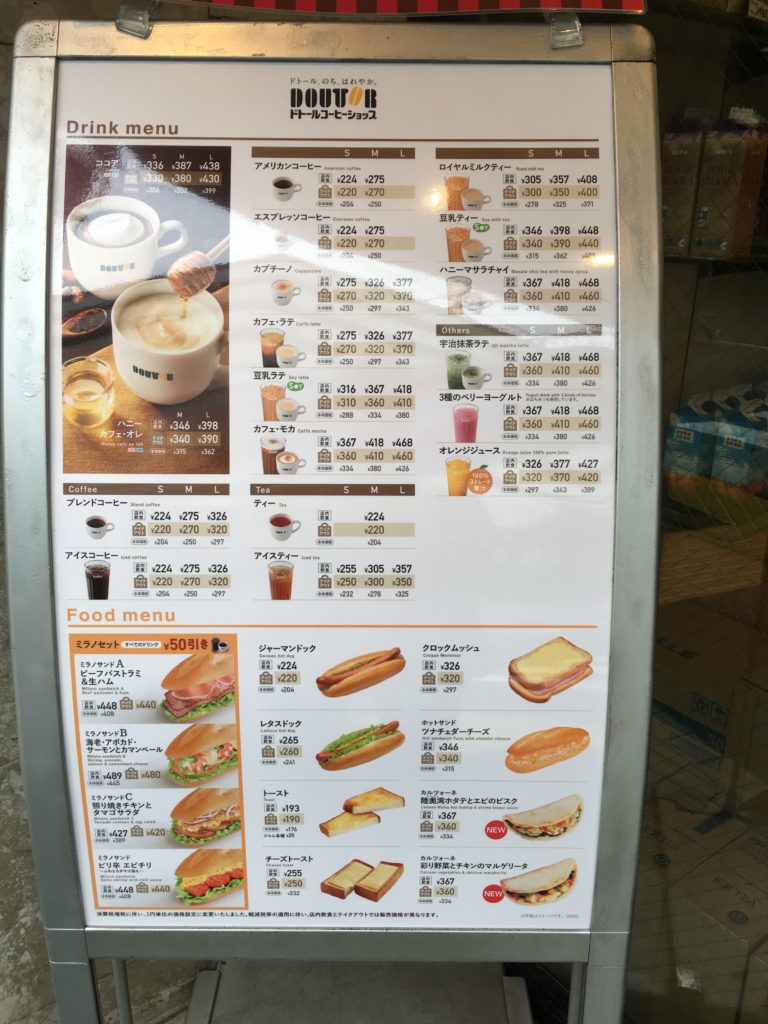
Doutor Menu with all kinds of inexpensive sandwhiches and drinks.
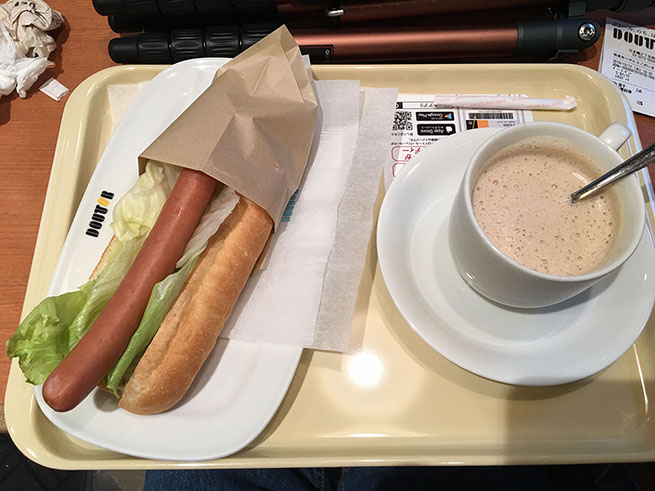
Doutor Lettuce Hot Dog and coffee – around $5.
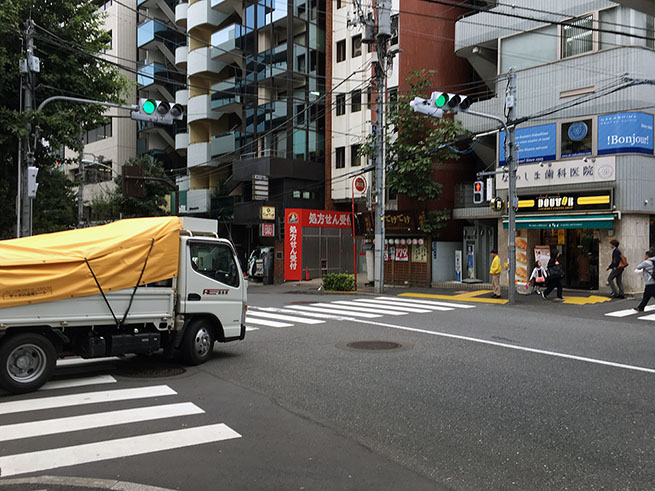
A Doutour on the right, in Iidabashi.
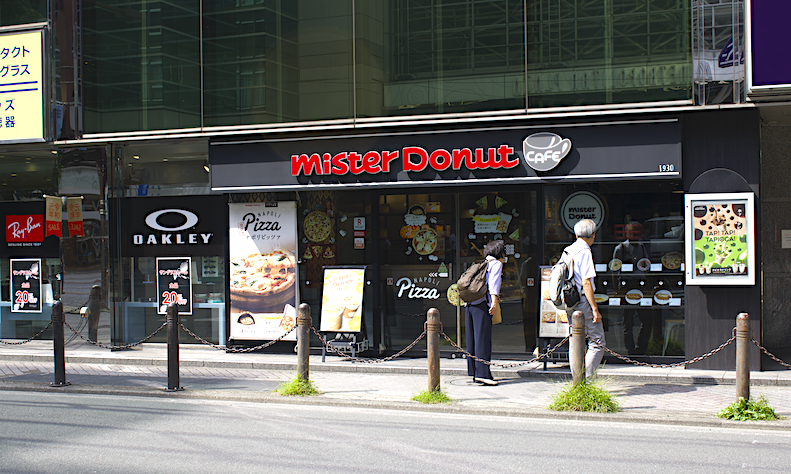
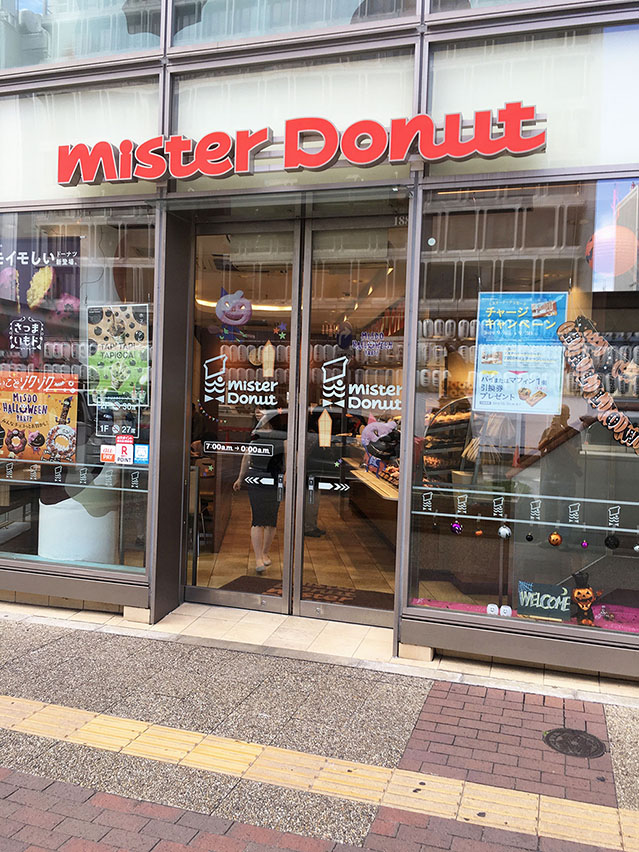
2 Mister Donuts in Ikebukuro. In fact there are 3 Mister Donuts in Ikebukuro. There is also a very nice one in Akabane, and other areas in Tokyo.

Speaking of Ikebukuro – there is also this Tully’s in the now popular Q Front east of the station.
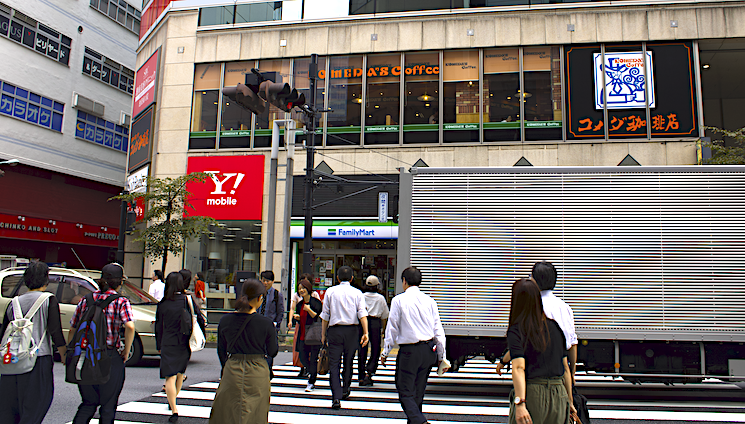
Komeda’s Coffee, Ikebukuro
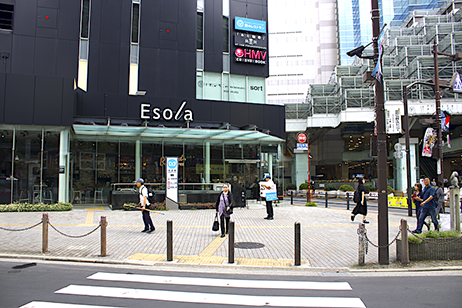
Roasted Cofee Laboratory in the Esola mall south of Ikebukuro Station.
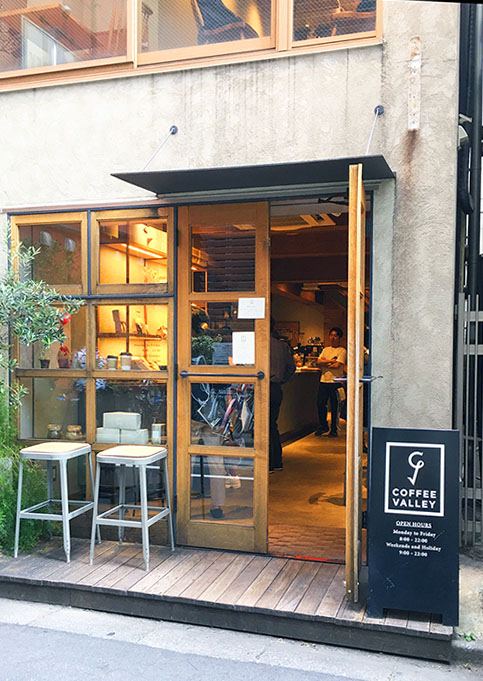
Legendary Coffee Valley is one of the best coffee shops in all of Tokyo hands down – and it has a nice 2nd floor seating area. Don’t miss it just southeast of Ikebukuro Station.
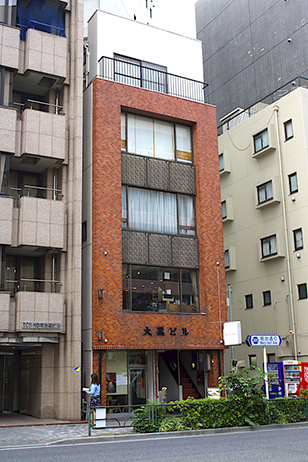
If you walk 1 mile south from Ikebukuro Station, you will find the Rocket Cafe on the west side of Meiji Dori. It also has a nice 2nd floor seating area. A must-visit. As a footnote if you walk far enough south from here you will eventually hit Waseda University about 2 miles to the south.

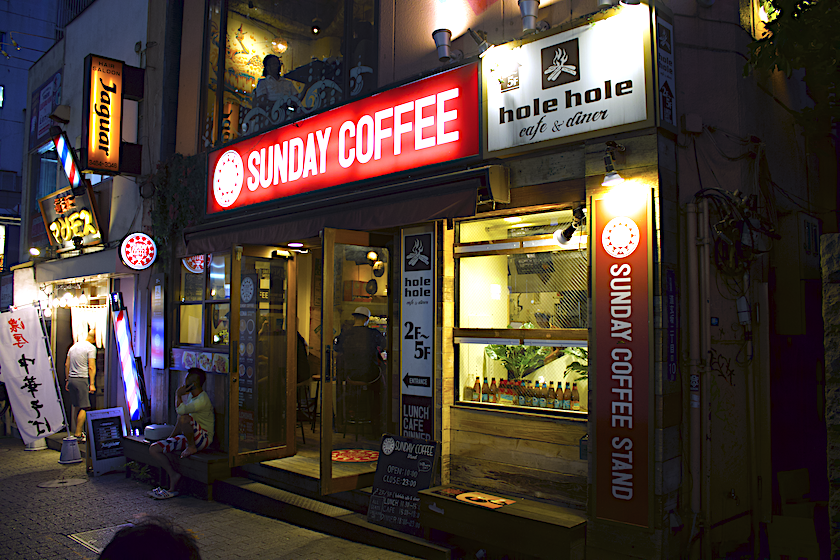
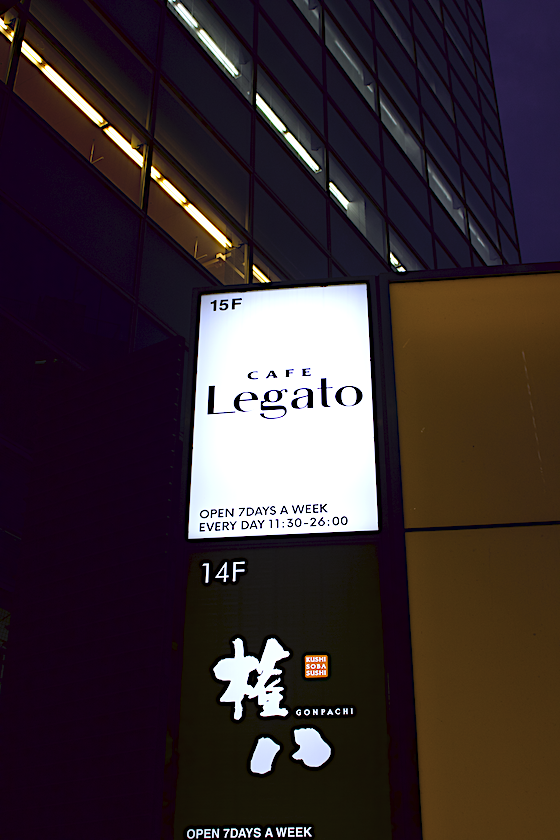
Cafe Legato and Sunday Coffee in Shibuya.
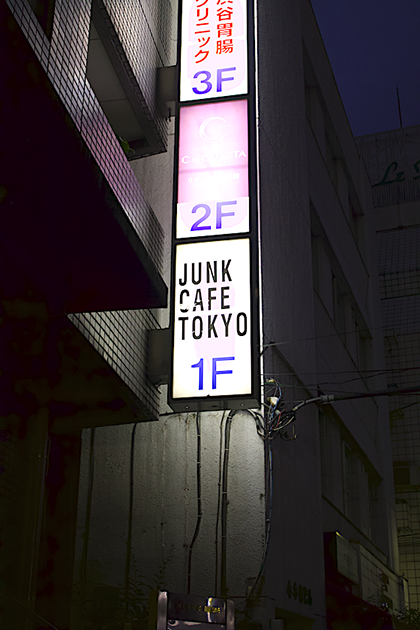
Legendary Junk Cafe, Shibuya – now closed.
Other restaurants + food malls
Many other restaurants, bakeries, and food malls abound, such as this food hall just west of the Shinjuku NTT HQ (aka “The Bubble Building”):


Bakeries abound everywhere – especially in train stations, such as this one – Little Mermaid Café in Komagome Station.

Another bakery in Shinjuku Station.

Sugar Butter Tree, Ueno Station
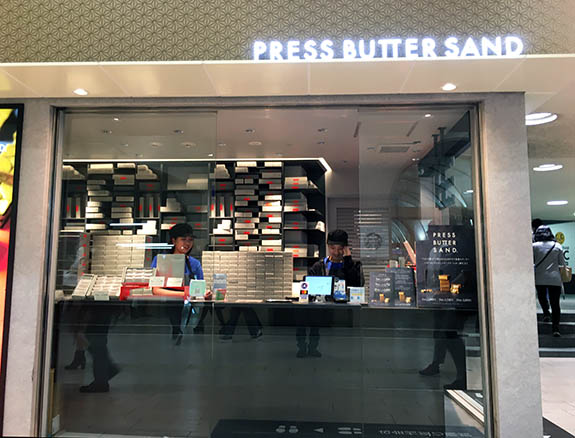
Press Butter Sand @ Shinjuku Station. There is also one inside Ikebukuro Station.
Online Stores
There are also a few online groceries which will ship food to you:
https://www.asianfoodgrocer.com/
https://99japan.com/pages/japanese-grocery-store
FOOD LINKS
LIVING on VENDING MACHINES for 24 HOURS in TOKYO!
Japanese Vending Machines Exposed ★ ONLY in JAPAN
https://www.youtube.com/watch?v=ZZmUuRG87sU&feature=share
https://www.youtube.com/watch?v=8YU0s5WAFr0&feature=share
Accomodation options – hotels, hostels, capsules.
There are several accomodation options in Japan – luxury hotels, resorts, ski places, Ryokan inns, smaller hotels, budget business hotels, and hostels.
We review just business hotels + hostels here since they tend to be cheaper.
By far, the very best value in Japan when it comes to hotels is the APA Hotels chain. There are hundreds of these all over Japan, and they are very reasonably priced. They are designed for business travellers, and have great rooms and service, although the hotel rooms tend to be smaller. Don’t let that deter you though – this chain of hotels is a great value for the money – some as low as $65/night USD, with far better accomodations than a similarly priced cheap Motel 6 in the US. Most of them have 4K TV, a fridge in the room, and power outlets + bathroom amenities. Most also have tiny desks in the rooms to work on. In fact, APA is an acronym for Always Pleasant Amenities – and they’re not joking. These are fine hotels. Well worth a look. There is even an APA just 1 train stop from Narita International Airport. If you want to avoid jet lag and want to crash on arrival, you can check in here for a few nights to recover, then move on to Tokyo on the Keisei Line which has a station in Narita City just a few blocks from the hotel. An easy way to make a long trip a bit easier.
Hostels
Hostels are a cheap way to stay in Japan – some as low as $25-$35/night but you pay in terms of inconvenience and discomfort. Some are capsule hostels, such as And Hostel in Akihabara and Sumida – which we highly recommend. First Cabin is an upscale larger modern luxury “tube hostel” similar to capsule hotels – but the rooms are larger, cleaner, more modern, and have a large TV. These are very clean first class hostels when you can sleep cheap. There is also one of these near the Sumida River in east Tokyo south of Sky Tree.
The downside to hostels + capsules are noise, lack of room AC control on a per-room basis, cramped quarters, and nowhere to stand up (although First Cabin also offers larger rooms which do have some floor space + a large table). The air in these places also tends to get a little stuffy. There are several First Cabins all over Tokyo – there is even one right in the middle of the hustle and bustle of Akasaka near the central gov’t that is worth a look. Beware however that First Cabin requires all residents to check out daily from 10:00 AM – 1:00 PM for cleaning. No exceptions. All rooms also include a small lockbox in which you can store valuables when you leave.
Most First Cabins have shared bathrooms, which are very upscale + clean. Floors are by gender – mens’s floors + ladies’ floors.

Looking out of a First Cabin room, at an empty one across the hall. Note the small black shelf on the left side. That’s where the lockbox is – and you can also set your stuff on top of it. There is also a metal rail along the top of your cabin inside to hang clothes on. The white shutter on front pulls down to nearly the floor for privacy.
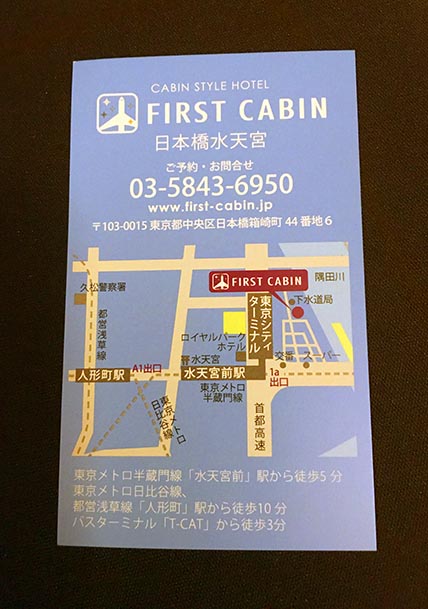
Outside of First Cabin we like And Hostel – as mentioned – in Akihabara, Sumida, and a few other locations. While not quite as upscale as First Cabin, they’re pretty good – clean, well ordered, and they also have the good sense to open floor windows to draft stuffy air outside. They have a lounge where you can sit on a sofa, and tables for work. Some of them have a kitchen you can use. These are pretty reasonable at $40-$50/night. Worth a look.
There are also a variety of smaller, older, privately-run capsule hotels – these vary in quality and price. Search Agoda for reviews + reservations.
Most hotel/hostel staff in Japan are very helpful – much more so than in the US – and many speak English as well. If you have any trouble or need something, most will be more than willing to help.
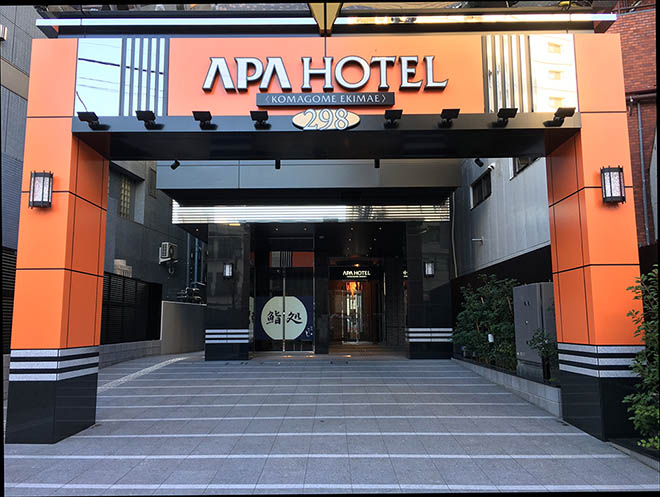
APA Komagome, east Tokyo. “Ekimae” means “At the station” or “In front of the station”.
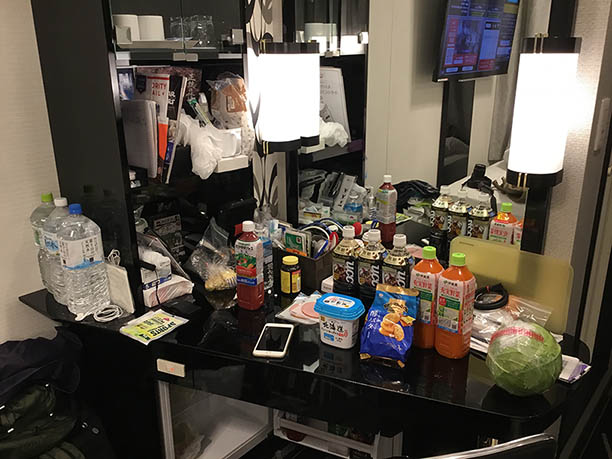
Our APA room desk – loaded with loot from Don Quijote discount food store – including 3, 1-liter bottles of UCC Cofee. The big yogurt container with the blue lid is around $1. Good stuff cheap.
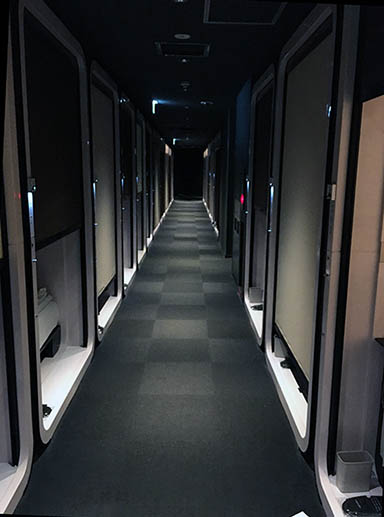
Inside First Cabin – like something from a 1970’s sci-fi movie. Be sure to keep quiet during sleeping hours.

Inside a First Cabin standard room.

First Cabin bathroom hallway.

First Cabin Atagoyama – near Shimbashi. Most First Cabins tend to be down little side streets in residential neighboorhoods, but there are exceptions, such as the one in Akasaka.
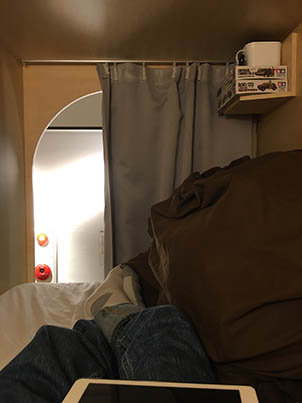
Inside And Hostel, Akihabara. You get a plywood tube with a matress, and a pull curtain for privacy. The room also has power outlets + a light – but no TV, unlike First Cabin. The plywood walls help deaden sound, which makes And Hostel much better than most. Plus And Hostel just has a comfy, easy-going feel. A bit Bohemian, but not too much.
Phones, computers, WiFi
Much has been written about using phones + WiFi in Japan.
We will try to keep this subject brief. It’s pretty simple.
For phones, your best bet is to bring a phone from your home country which offers an affordable fixed monthly plan with unlimited roaming. Such plans in the US include UltraMobile and T-Mobile. UltraMobile offers a fixed $19/mo international roaming plan which allows you to use any western GSM phone in Japan. Up until 2016 foreigners could buy a Japanese phone in Japan, but this has now been disallowed by the Japanese gov’t over terrorism concerns. If you absolutely must have a Japanese phone, have an associate or company buy one for you there for you to use. Note that prepaid is not big in Japan and you’ll have to have the company pay the bill for you as well.
As for WiFi there are plenty of options – you can buy small roaming WiFi boxes at most electronic stores in Japan such as Bic Camera – you pay a fixed fee per month (usually $40-$70) and the little box piggypacks on the local cell network. There are various vendors such as eConnect Japan and others. Speeds can range from fast to slow, depending on service, and bandwidth. Most electronic stores are eager to sell/rent these boxes to foreigners and will be more than happy to help explain the services and features in both Japanese and English.
However, today, most hotels and many department stores in Japan now offer free WiFi. Some municipalities do – such as at a public hotspot shown below. Check each city’s website before you go. These are easy to use and usually require just an accept on a web page, or a free email registration. To use them, just get in range of the public WiFi signal and log in.
Computers in general, and laptops in particular are generally cheaper in Japan than the rest of the world – except perhaps for the high end models. Good cheap laptops by Acer or Asus can be had in most electronic stores for $400-$700. Make sure you ask for one with an English keyboard if you don’t speak Japanese as most models in Japan have Japanese. Some models have both on the same keyboard.
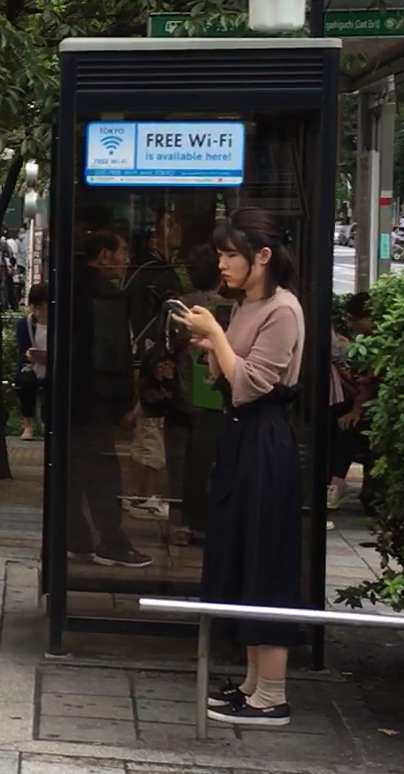
A free WiFi spot in Ikebukuro, Tokyo. Just stand nearby + log in. Most of these WiFi booths in Japan are old converted payphone booths. In fact many of them still have their green payphones inside. But of course, no one uses payphones anymore.
Transportation – Rail – IC cards
Most major railways in Tokyo and other large cities have IC electronic fare cards. You buy one from a ticket machine at a station, add money to it on the same machine, and swipe it at entry/exit turnstyles to pay. Trip payment is automatically deducted when you exit the turnstyle. No more paper tickets to buy. The gates have small lighted blue pads on them to indicate where to swipe. The two major IC card systems in Japan are Suica and Pasmo. Osaka also has a few systems of its own.

If you have a late model smartphone, you can set them up to also work as an IC payment system using services such as Apple Pay, Google Pay, and others. Late model smartwatches such as Apple Watch are also now adopting the tech and will allow you to use them as payment devices. You can also use these services to pay in some conbini in Japan (look for the respective company pay symbols on registers in stores). You just add money to your account your phone/watch is connected to, then swipe it over the IC reader to pay.
For a complete review of railway IC cards + other electronic payment methods in Japan, see our full post.
Additional Photos
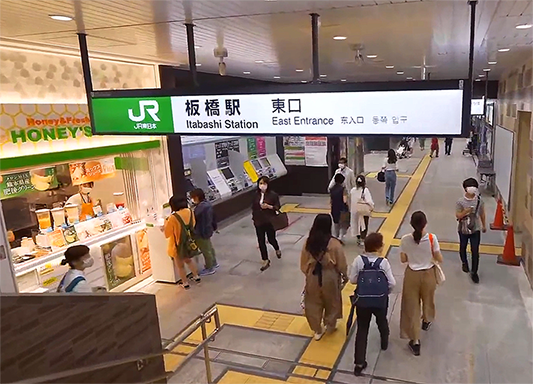
Itabashi Station, western Tokyo. The bank of ticket machines is in the center just under the station sign.
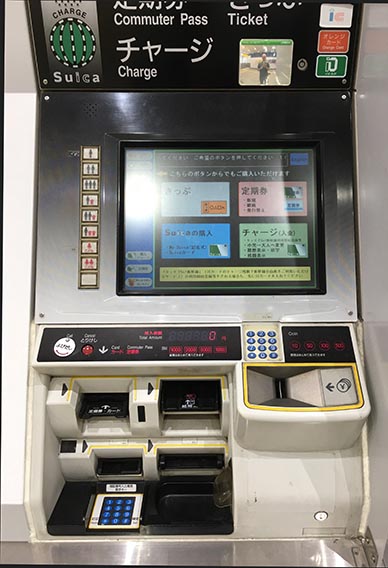
Older-style ticket machine converted to handle Suica IC cards. The tall row of mechanical push-buttons on the left is now largely unused. Newer machines are 100% touchscreen. The slot on the right with the yellow border also allows you to toss Japanese coins in to add fare.
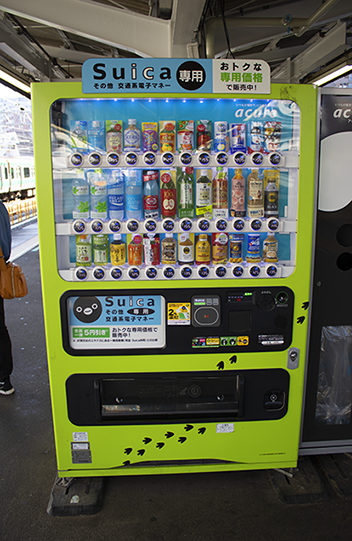
A Suica-enabled drink vending machine. The card reader is the small white circle on the center panel. Just make your selection on the top panel and slap your Suica card on the reader to pay.
LINKS
https://www.jreast.co.jp/e/pass/suica.html#category10
https://www.youtube.com/watch?v=9TuVRCXynpA\
https://www.youtube.com/watch?v=Ai5lT9bXif8
https://www.youtube.com/watch?v=U_g01JFvul0
https://tokyocheapo.com/travel/pasmo-suica-cards-tokyo-travel/
https://www.jreast.co.jp/e/pass/suica.html
Pasmo/Suica Cards: Smart Tokyo Travel (w/ Instructions) – Tokyo Cheapo
https://tokyocheapo.com/travel/pasmo-suica-cards-tokyo-travel/
https://www.youtube.com/watch?time_continue=116&v=X-01KNXILi8
How to return your card:
https://www.japan-rail-pass.com/common-questions/difference-Pasmo-Suica
Matcha Guide:
https://matcha-jp.com/en/30
Only cash (Japanese currency) can be used to recharge Suica cards.
https://matcha-jp.com/en/29
Buying Paper Tickets With Your Suica Card
https://matcha-jp.com/en/834
https://trulytokyo.com/tokyo-smart-cards-pasmo-and-suica/
https://www.jreast.co.jp/e/pass/suica.html
https://www.japan-guide.com/e/e2359_003.html
https://tokyocheapo.com/travel/suica-card-guide/
http://www.japaniverse.com/prepaid-suica-card/
https://www.govoyagin.com/activities/japan-tokyo-get-suica-japans-most-convenient-prepaid-e-money-card/2377
https://m.kkday.com/en/product/18569?cid=2636&ud1=English_o&ud2=jp_18569&gclid=EAIaIQobChMI1br-l5mj4gIVleN3Ch3CmwoGEAMYASAAEgIuPvD_BwE
https://www.tripadvisor.com/ShowTopic-g298184-i861-k10752329-Where_do_i_buy_Suica_card-Tokyo_Tokyo_Prefecture_Kanto.html
https://www.simcardgeek.com/product/buy-suica-card/
https://www.thejapanguy.com/how-to-get-a-suica-card/
https://www.japan-experience.com/japan-rail-pass
https://www.japan-rail-pass.com/
https://www.japan-experience.com/japan-rail-pass/faq
WiFi
Thanks on your marvelous posting! I genuinely enjoyed reading it, you can be a great
author.I will make certain to bookmark your blog and definitely will come back in the future.
I want to encourage one to continue your great
work, have a nice evening!
Thanks!
Very descriptive blog, I liked that a lot. Will there be a part 2?
Maybe in the future. Most of our other topics will be covered in their own posts.
This website was… how do you say it? Relevant!!
Finally I have found something which helped me. Appreciate it!
Thanks!
Excellent blog! Do you have any hints for aspiring writers?
I’m planning to start my own site soon but I’m a little lost on everything.
Would you advise starting with a free platform like WordPress or go for
a paid option? There are so many choices out
there that I’m totally overwhelmed .. Any tips?
Thanks a lot! adreamoftrains best web hosting sites
WordPress is a good place to start – it’s easy to install and learn – and doesn’t require a lot of coding skills. See the “WordPress famous 5-minute install” to see how to set it up.